Posted by Martin Andersen on 08-16-2007 09:28 AM:
Tekke tertiary gul
Hi all
I have just acquired a tekke main carpet, and I am very happy about
it.
The carpet has a tertiary gul which I have not seen before. Could anybody
direct me to a published reference (on the net or in books) to the gul ?
The
carpet also has a border element which I havent seen before.
Any comments and
information is much appreciated.
kind regards Martin
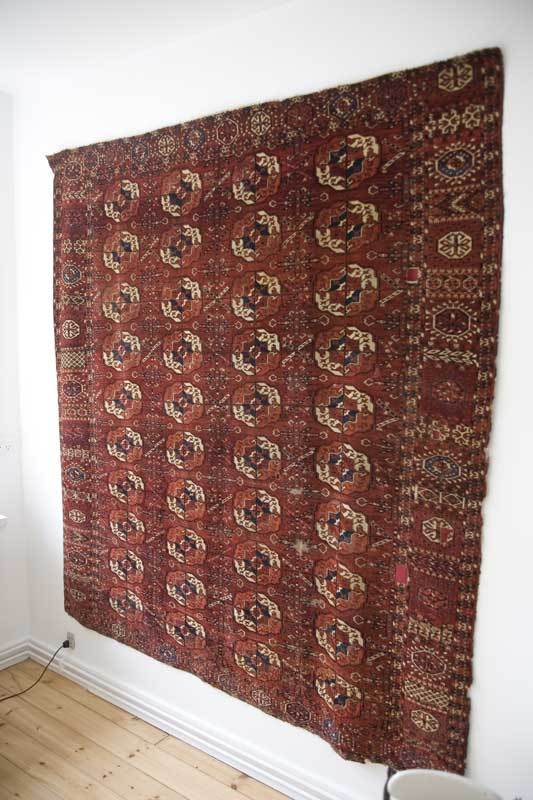
main carpet
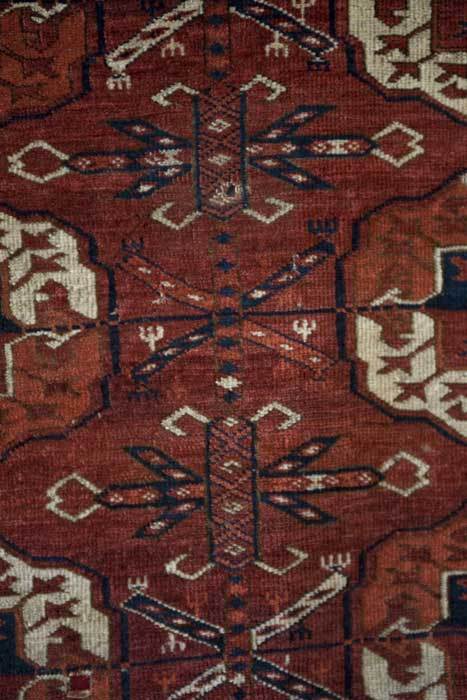
tertiary gul
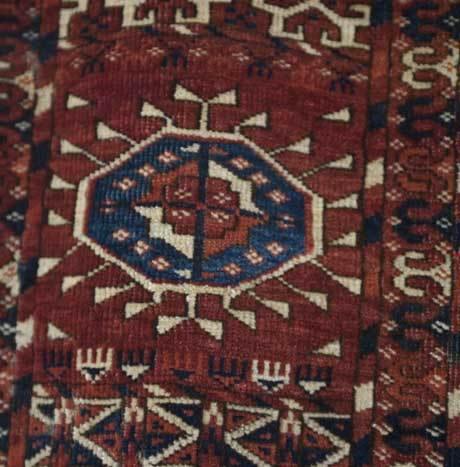
border
Posted by R. John Howe on 08-16-2007 03:55 PM:
Mr. Anderson -
I can't answer either of your questions, although I
looked about a bit. So what follows here is speculation.
I want to start
with the sections between the cartouches in the main border of this rug. I have
heard that Tekke weavers often treated this space as a place in which to display
their virtuosity. And there are rugs in which weavers place a wide variety of
designs here, sometimes seeming not to repeat any within a given rug.
I
think that the weaver of this piece provides evidence that she has this tendency
to display her virtuosity in this area. More, I suspect (and this is the
speculation) that she did not stop there but made moves of a similar sort
elsewhere.
There are no border cartouches with stars, so I think this
piece is likely later than at least some of those that have them. Some main
border cartouches do display the "crossed ramshorns" element Stone calls an
"aina" device. The internal drawing of the cartouches about which you ask ARE
different from any specific usage I know, but the devices used are all within
the Tekke vocabulary. The center device in these cartouches is a kind of gul
with features of a "chuval" gul (e.g. the quartering and associated use of
color) but with an outside outline more like an "entman" or "diamond"
gul.
The tertiary gul is the most puzzling. I think there are tertiary
usages in some Tekke pieces but this one looks different to me. Notice that it
has the center vertical piece of "chemche" minor gul (there are a number of
varieties of chemche guls) and then the crossed strips and the hanging
"pitchfork" devices. This device looks composed to me, another example of the
weaver "showing off" so to speak. Not only have I not found another instance of
it but notice that it seems to lack what might be called "design coherence." Its
components do not unite to form an integrated whole. Instead, the eye is
attracted to its parts. Moshkova shows an instance of a chemche gul that has
similar crossed elements with interior diamonds (O'Bannon, p. 190, design 7) but
in the rendition in your rug they are far longer and draw too much isolated
attention to themselves. And the "pitchfork" devices hanging off are the most
convincing feature, for me, indicating that this weaver has put some things
together for display that do not work very with one another.
That said, I
think this is an interesting, attractive rug that many of us would be pleased to
own.
Others may be able to find close examples or to make other
suggestions.
Regards,
R. John Howe
Posted by Martin Andersen on 08-17-2007 02:58 AM:
Hi John
Thanks for your comments.
I suppose showing off was not one the
most accepted features in the rather strict tekke tradition. But, as an artist
myself, I can sympathies with the weaver :-) . I think that the asymmetries and
the diagonal directions of the tertiary gul gives the carpet a very strong
presence. And I do think that the overall strong pattern of the main gul still
holds the composition on place. But of course that may be a matter of personal
aesthetics, and then again the relationship between living tradition and
personal showing off might in the time of the weaving have be seen as a
difficult balance.
Regarding the the age of the carpet, would you say that I
far off by placing around mid 19th ?
Kind regards
Martin
Posted by Steve Price on 08-17-2007 05:24 AM:
Hi Martin
You asked if anyone knew of a piece with the same tertiary
gul and border elements. Yesterday, a Rugdom personality with a reputation for
transmitting misinformation (and disinformation) sent me an e-mail saying that
they occur in a rug in The Oriental Rug Collection of Jerome and Mary Jane
Straka, 1979. Here, with the invective deleted, is the text of his message
(copied and pasted from the original):
Tertiary gol question:
this
rug is a later example of one in the stratka
collection and several others
that have drifted thru
the market
the tertiary gol and the border
elements are part and
parcel of these pieces
go ahead, steev, show how
smart you are ...
I delayed posting this until I could check the
book. Sure enough, Plate 26 is a Tekke carpet of similar design, but with 11
rows of main guls (yours has 10). It is attributed by the Strakas to the
mid-19th century. Maybe it is, maybe it isn't. Since there are no reliable
criteria for determining this, I'd say the same about
yours.
Regards
Steve Price
Posted by Martin Andersen on 08-17-2007 06:17 AM:
Hi Steve
Thank you very much for the information, and thank you for
checking it. I will try to find a copy of the book.
And thanks to the Rugdom
personality too (from the harsh tone I suppose I know who :-) )
regards
Martin
Posted by Steve Price on 08-17-2007 06:54 AM:
Hi Martin
The book is well worth having; it's a great collection with
just a few mediocre pieces in it. It was published nearly 30 years ago, when
color printing was much more expensive than it is now, and many of the photos
are in black and white. Plate 26 is one of those, although the caption waxes
rhapsodic about the colors.
Regards
Steve Price
Posted by R. John Howe on 08-17-2007 07:52 AM:
Mr. Anderson -
I, too, have looked at the piece in the Straka catalog,
and it is quite like yours.
Steve has likely not scanned it because, as
he says, the image is black and white, but I am providing scans of it below
because the tertiary gul is nearly identical to that in your piece and gives the
lie to my suggestion that it is likely "composed."
Here is an image of
the overall rug from Straka:
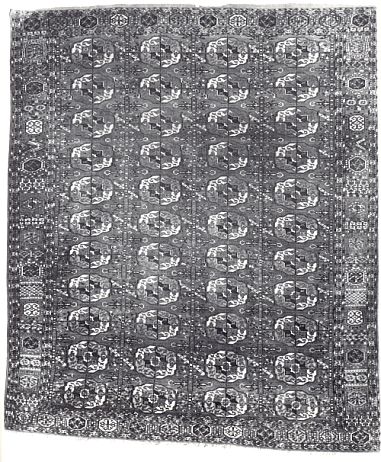
Here is a closer look at a corner.
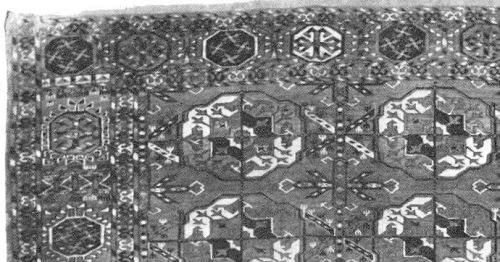
And here is an image, closer
yet, showing how similar this tertiary gul is to that in your piece.
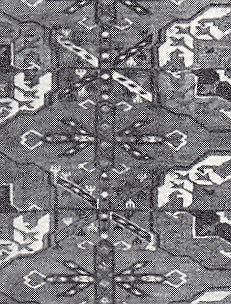
The only real
difference I see is that the "pitch forks" are arrayed all along the length of
the diagonal bars on the Straka rug. But it's clearly the same
device.
Regards,
R. John Howe
Posted by Richard Larkin on 08-17-2007 08:26 AM:
Hi Martin,
Is your rug as square as it appears in the picture, or is
that an illusion due to the angle from which it was taken? I find that feature
striking as well. I would think it augurs for relatively greater age. The
Strakas' rug is also much on the square side.
How about a nice close-up
shot of the back?
__________________
Rich
Larkin
Posted by Martin Andersen on 08-17-2007 08:28 AM:
John Howe
Thanks for taking the trouble with the scans. Its very
interesting to se the resemblance.
And it do looks like (as rugdom
personality pointed out) the border cartouche is connected to the tertiary gull
:
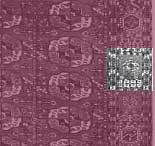
Straka
border cartouche
Posted by Martin Andersen on 08-17-2007 08:46 AM:
Hi Rich Larkin
Yes the carpet is almost square, ca 200 x 212 cm.
And
here is a photo of the lower back with one of the cartouches :
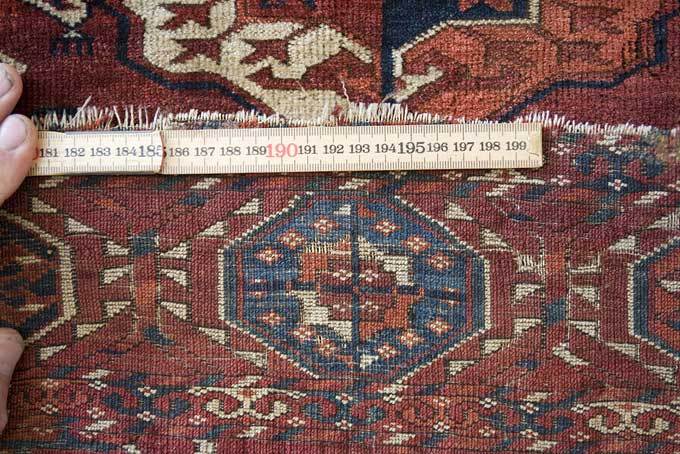
kind
regards
Martin
Posted by Marvin Amstey on 08-17-2007 06:29 PM:
As to relative age, I would choose Martin's as older than the Straka rug. I
seem to remember somewhere - possibly Pinner, that 10 x 4 guls are the old
version; more rows are later. Anyone may speak up if I'm off base. Nice rug!
Posted by R. John Howe on 08-17-2007 11:17 PM:
Marvin -
Using design indicators for age is probably beyond our ken,
but I have associated Tekke main carpets with four stars in their main border
cartouches with age.
The Straka carpet has some of those. Mr. Anderson's
has some with the "crossed rams horns" also seen on the Straka piece, but not
the stars.
Not, conclusive at all, but a possible
indicator.
Regards,
R. John Howe
Posted by R. John Howe on 08-18-2007 06:30 AM:
Mr. Anderson -
You mention that there is a place the border system of
your rug where the designs used in the tertiary gul are also used.
You
mention, and seem to highlight in an image, a "cartouche."
"Cartouche," I
suppose, could be used to refer to any compartmentalized area in a rug. I have
been using it in a more restricted sense to refer to the hexagonal shaped
devices that contain some further instrumentation. For that reason, I see the
place that seems to me to contain elements of the tertiary gul as an "in
between" area.
Here is the one that seems most similar to me:
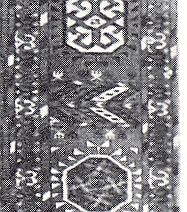
The elements are not
arranged as in the tertiary gul, nor is the center "post" included, but most of
the other devices used in the tertiary gul seem to be
present.
Regards,
R. John Howe
Posted by Martin Andersen on 08-18-2007 07:20 AM:
R. John Howe
You are very right about the in between spaces in the
border resemblance to the tertiary gull. There also is very large amount of the
"pitchfork" devices used all round the border.
But the section I
highlighted in the Starka carpet was the octagonal border cartouche. The
resolution off the Straka image is rather small but I do think that it looks
very much like the octagonal border cartouche in my carpet.

Straka cartouche
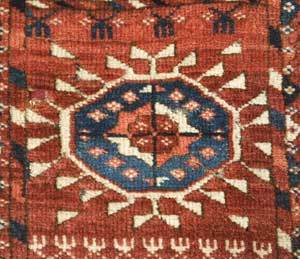
my
cartouche
regards Martin
Posted by Martin Andersen on 08-18-2007 07:22 AM:
Hi All
I understand that the hole age attribution is rather unsecure,
and at least has to be seen as rough estimates. And perhaps its not that
important.
But there seem to be consensus that the star/octagonal border
cartouche is old, predates tekke salor split (though I do think I have seen
carpets with the star/octagonal cartouche which I would not think were that
old)
Are there any other consensus regarding the relations between
specific Tekke border cartouches and tribe/geography/Klans/families ?
I
find it very interesting that there seem to be a direct connection between the
tertiary gull and the border cartouche in the Straka carpet (and in mine). I
suppose it could be the product of the same individual (showing off :-) ). I
assume that one individual weaver during a lifespan would have produced a number
of more or less related carpets ? But somehow I think that the emblematic nature
af a cartouche would be more meaningfull in a larger structure (family or
klan)
Any comments or speculations are very much appreciated.
Kind
regards
Martin
Posted by R. John Howe on 08-18-2007 08:48 AM:
Mr. Anderson -
Someone has said that one sign of experience is knowing
when one should stop with attempts at specificity in efforts of
attribution.
There are still some pieces in which the indicators are
mixed enough that experienced folks will only say "Turkmen" or even more broadly
"Central Asian."
The move to use tribal names for Turkmen attributions is
still quite young and there are efforts to further specify some of the broader
tribal designations. Both the Yomuts and the Ersaris fall into that
category.
There are undoubtedly Tekke subgroups and likely these have
been specified to some extent. And in the older literature there were references
to "Akhal" Tekkes vs "Merv" Tekkes. Thompson alludes to Merv Tekke devices in
some of his descriptions in his 1980 catalog. But in general in the literature,
there has been a backing away from attempting to say which Tekke rugs were woven
by which Tekke subtribes.
Others may be more adventurous
here.
Regards,
R. John Howe
Posted by Steve Price on 08-18-2007 08:52 AM:
Hi Martin
Consensus opinions are often nothing but marketplace myths
or other fabrications that have gained credence through repetition. The
important question to ask of any consensus opinion is, "What is its basis?"
There was, at one time or another, consensus opinion that the earth is
flat, that it is at the center of the universe, and that thunder is the sound of
the Gods bowling.
The Straka rug and yours seem to have enough in common
with each other and different than most other Tekke main carpets to make it
reasonable to suppose that they were woven at more or less the same time (say,
within 50 years of each other) by the same group. Things get progressively more
uncertain as their attribution gets progressively more specific. The comfort
zone between desire to know and willingness to accept as being unknown varies
from one person to another. I think it's fairly important that we recognize that
fact (as you seem to, from what you say).
Regards
Steve Price
Posted by Martin Andersen on 08-21-2007 05:37 AM:
Hi All
Thanks for your comments. It was very informative.
I
suppose we all primarily love our rugs for their beauty - and secondly for their
uniqueness and peculiarities :-)
Kind regards Martin
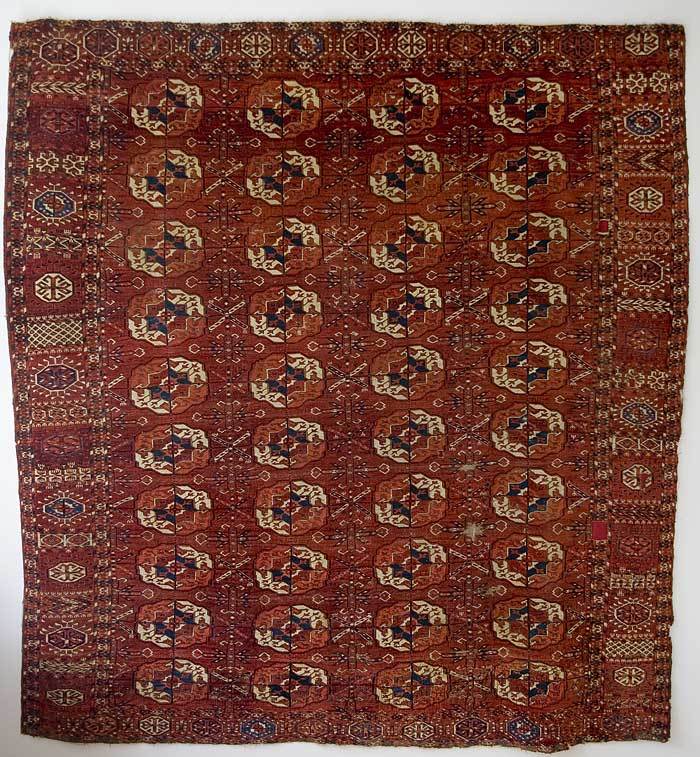
Here is a final frontal
shot off the carpet.
Posted by Richard Larkin on 08-21-2007 06:41 AM:
Hi Martin,
It's a beauty, all right. It's remarkable how much it
resembles the Straka one, even comparing to the black and white image. I'd love
to see them side by side in the wool.
__________________
Rich
Larkin
Posted by R. John Howe on 08-21-2007 07:08 AM:
Dear folks -
There were a couple of Turkmen rug events here over the
weekend.
In one of them, Bob Emry, brought a Tekke main carpet, and said
that one of its interesting features is that it had a small gul form inserted as
a patch in one corner of a main border.
He said that he has wondered what
this patch was from since the gul form seemed unusual. And he credits Turkotek
and this thread in particular for having answered that question for
him.
The gul form used as a patch in his Tekke piece is this
one.

I
have encouraged Bob to put up an image of his piece and its patch and maybe he
will do so yet.
It is remarkable that a patch should have been taken from
a piece that may also have had tertiary guls.
Interesting possible third
instance.
Regards,
R. John Howe
Posted by Rich Larkin on 08-21-2007 09:27 AM:
Blimey!
Hi John,
In the Disney film, "Treasure Island," they gave Long John
Silver (played by Robert Newton) the "black spot" on a page out of a bible.
"What fo-o-ol cut a bible?" sez 'e.
I wonder who cut out that patch for
Bob Emry's rug. No doubt, the source was already quite compromised.
Posted by Martin Andersen on 08-21-2007 01:47 PM:
Hi All
Rugdom Personality has posted a picture of a carpet which also
has the combination of the tertiary gul and the cartouche.
I take the liberty
off posting it here. Hope I am not offending anyone by doing it.
So that's
at least 3 carpets with the same combination of tertiary gul and
cartouche
regards Martin
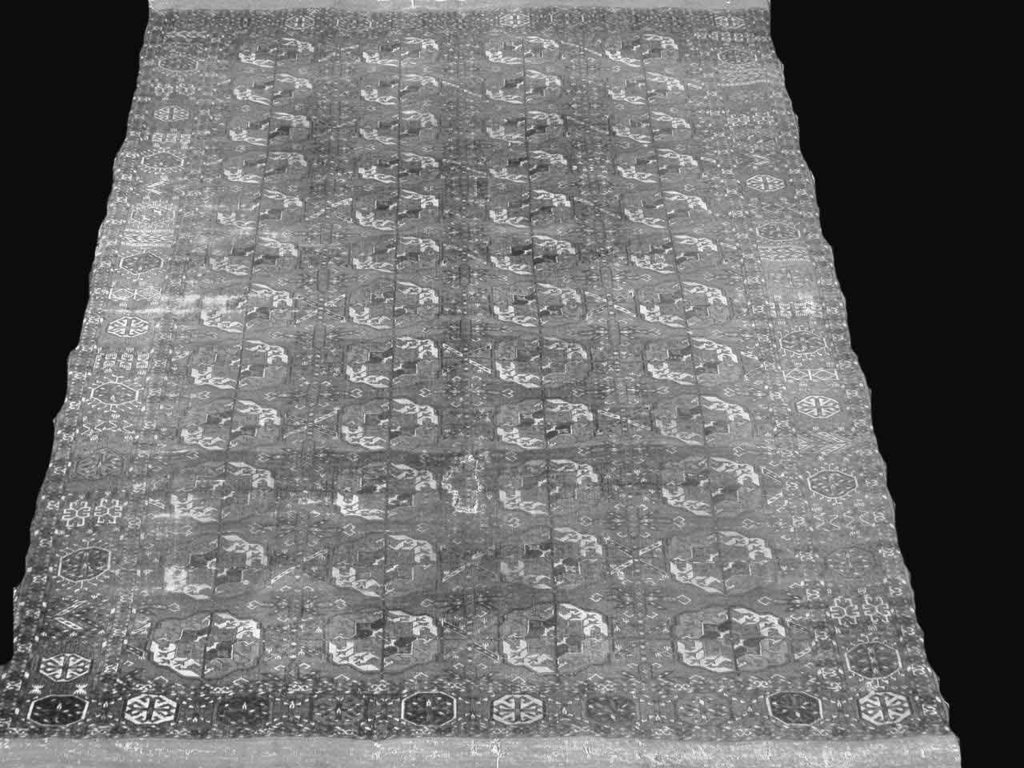
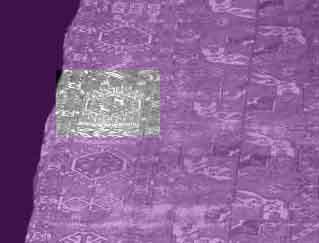
Posted by Steve Price on 08-21-2007 02:03 PM:
Hi Martin
Nobody's offended by posting those images, although they
aren't exactly eye candy. Mentioning Jack Cassin's name is OK, too, as long as
we dissociate our opinions of the rug from our opinions of him (which anyone is
free to express on the forum that we have set up specifically for that
purpose).
I agree that what appears to be an association between using
that odd motif once in the border and using the tertiary gul in the field is
interesting and suggests that these rugs belong to the same group (whatever that
means; probably that they were done at about the same time and place).
As an aside, this thread and those on Cassin's site have probably set a
record for number of different misspellings of one name (Jerome Straka's family
name).
Regards
Steve Price
Posted by Robert Emry on 08-21-2007 08:54 PM:
My patch
Hello All:
As John Howe mentioned above, I do have an old Tekke rug
that I acquired some months ago that contributes indirectly to this thread. It’s
a nice old Tekke rug in its own right, and could date from the mid 19th century.
It has six columns of guls, which is more than most old Tekke carpets, but not
unheard of—for example see Jourdan’s figure 42. Here is the whole
carpet.
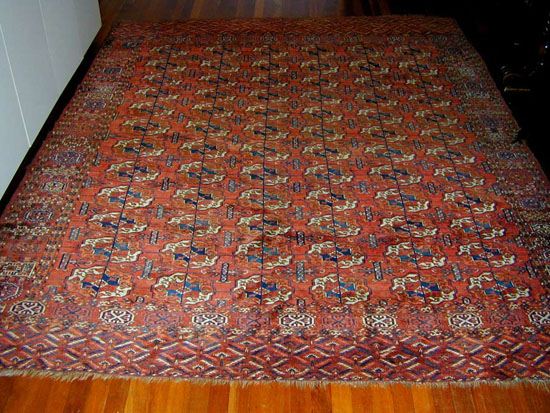
Apparently a long time ago, one corner of the carpet suffered
some kind of violent accident, and had been mended by sewing up some rips, and
sewing in some patches. It was the larger patch that intrigued me; it had a
design that I hadn’t seen before. Here is a detail of the corner of the rug with
the patch.
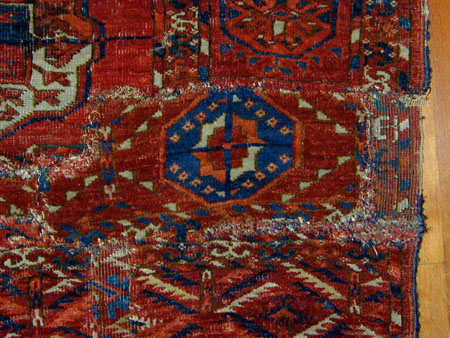
As you probably know, nearly all old Tekke carpets have one of
two designs in these octagonal border elements—the octagons either enclose four
eight-pointed stars, or crossed double kochaks (ramshorns), and some old carpets
have both designs. I was fairly sure that the patch in my carpet was also from a
Tekke pile weaving, but I couldn’t find anything like it in the literature. I
sent images of it to several people who had seen lots of Turkmen rugs, and none
could recall having seen this design either. Then last weekend as I checked out
this thread on Turkotek, there it was, with reference to another in the
literature, and a third has now been cited. Because all three examples of this
border cartouche are associated with a particular, complex tertiary gul, it
seems most likely that the patch in my rug came from another similar rug.
Posted by Robert Emry on 08-21-2007 10:16 PM:
The tertiary gul
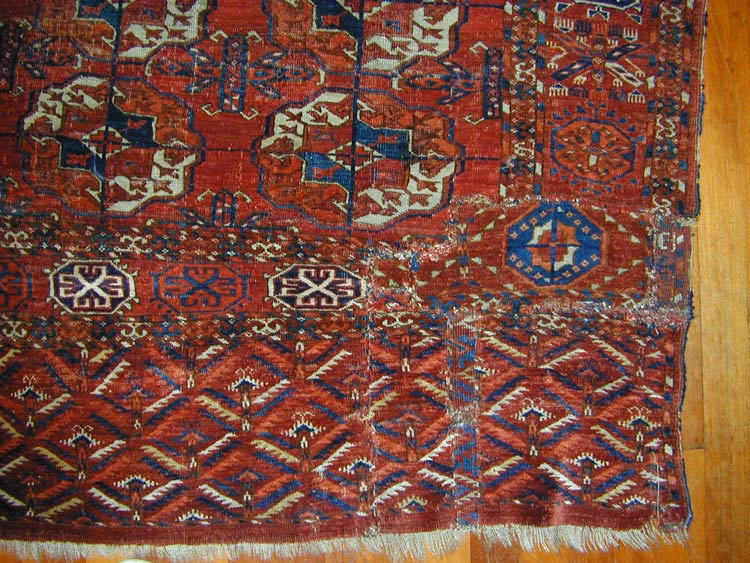
The Tekke rug
that I mentioned and illustrated above also has another item of interest to this
"tertiary gul" thread. As John Howe also mentioned earlier, the spaces between
the border octagons of old Tekke carpets often seems to be used to show just how
many different designs the weaver could remember. My carpet has such a "catalog"
of designs, and repeated several times among them is the same design used for
the "tertiary gul" in the rugs that are the main subject of this threads. A
slightly broader view of the patch shows (image below), at upper right, one of
these tertiary guls. This image also shows that in my carpet, the octagons of
the side borders enclose the double kochak cross (with rams horns at the end of
the axes of a cross or plus sign), whereas the end border are a variant that
seems unorthodox for Tekke borders---the kochak design is rotated 45 degrees so
that the rams horns are at the ends of an "X" (a design more often seen as the
central element of large guls of main carpets, for example the Tauk Nosca guls
of some Yomut and Chodor carpets).
Posted by Martin Andersen on 08-22-2007 04:16 AM:
Hi Robert Emry
That's fascinating.
If there was a connection
between the "cartouche" and the tertiary gul, then perhaps the person who
repaired the carpet found the "cartouche" to be the prober patch because there
in the border just above was the design of the crossed pitchfork gul !
Off
course pure speculation, but it might be the answer to Richs and Long Silvers
question "what fool..." :-)
Another thing I am wondering about are the
pitchforks. I understand that the Chemche gul is associated with arrow and bow.
Are the pitchforks, which I suppose are rather frequent in borders, associated
with any known figuration ? They do look a lot like claws, could the crossed
tertiary gul be some kind of animal representation ?
Kind regards
Martin
(and sorry for any misspellings, English is not my native
language)
Posted by Martin Andersen on 08-22-2007 04:35 AM:
Hi Steve
I just got a copy of the Straka Collection book (signed and
numbered :-)), very nice book. And it must have been a very interesting
exhibition.
Kind regards
Martin
Posted by Steve Price on 08-22-2007 05:59 AM:
Hi Martin
The Straka Collection is a beautiful book, and the
"black" Marasali on the cover may be the most published (and rightly so)
Caucasian rug in the world.
An e-mail message from Cassin arrived last
night. I won't inflict the whole thing on anyone, but the following excerpt
seemed funny enough to be worth sharing.
the only misspelling of
stratka's name on our site was
done by someone who came from yours
...
(emphasis added)
Regards
Steve Price
PS -
Please, despite my diversion here, let's keep the thread's focus on the rugs.
Thanks.
Posted by Patrick Weiler on 08-22-2007 11:06 AM:
How Lucky Can You Be?
Martin,
The "pitchfork" motif is probably a protective amulet form.
Turkmen amulets are often triangular, supposedly denoting fertility and also
helpful for averting the evil eye.
You can find many Turkmen amulets of
silver, with beads hanging like a fringe below them, quite similar in appearance
to the motif on these rugs.
This is speculative, of course. But not as
speculative as claiming that the boteh is really a rendition of a rabbits foot -
another "good luck charm". Not too lucky for the rabbit, though, but also
denoting fertility.
Patrick Weiler
Posted by Martin Andersen on 08-22-2007 02:59 PM:
Hi Patrick
The analog to the silver works seems very valid, a kind of
parallel to the protective "Fatima's hand"
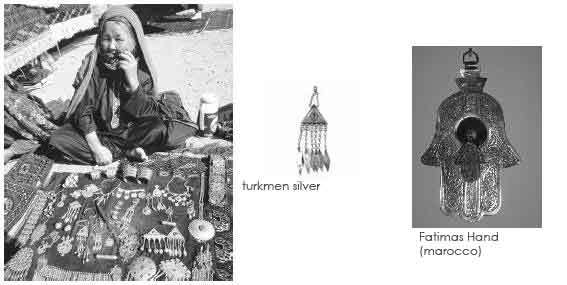
After looking more
closely at all the tertiary guls at my carpet its clear that the pitchforks has
two different layouts :
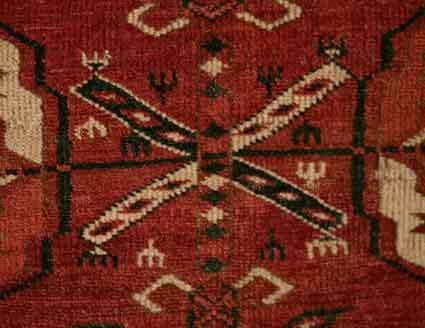
1 : At the end off each diagonal (exactly 4 on all gulls) a
"triangle with fingers" filled out with a second color.
2 : More randomly
placed along the gull, sometimes not attached, a simpler one color "fork on a
stick".
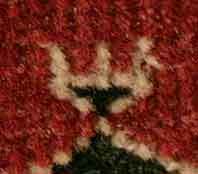
1.
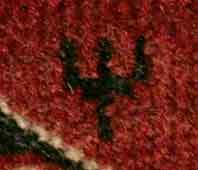
2
The crossed gul in the border of Robert Emrys looks
more complex, with longer arms on some of the forks :
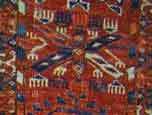
Robert Emrys
carpet
Sorry if I am going to much into details which may be trivial
and may lead to nowhere. But perhaps the forks on the gul is a combination of
protective fertility signs and some kinds of claws ? I do think that the gul
(perhaps especially the one on Robert Emrys border) looks like some kind of
winged beast :-)
Regards Martin
Posted by James Blanchard on 08-22-2007 03:39 PM:
Amulet? comb? animal?
Hi Patrick,
I have seen various interpretations of the figurative and
symbolic meaning of those "pitchfork" devices. Several authors have referred to
them as protective amulets, as you have noted. Others have simply described them
as representing the combs used to tamp down the wefts. I think I also read about
them being simplified versions of animals. Their use in conjunction with "trees"
in Tekke engsis calls to mind the "animal tree" construct, but perhaps that is a
red herring. Below are a couple of examples from rugs I own (an engsi and a
"Beshir" rug).
Previously we had a discussion on Turkotek about "tamgas"
and their meanings. I wonder if there would be interest in looking at the use of
"amulets" across different Turkmen and other tribal
groups...
James.
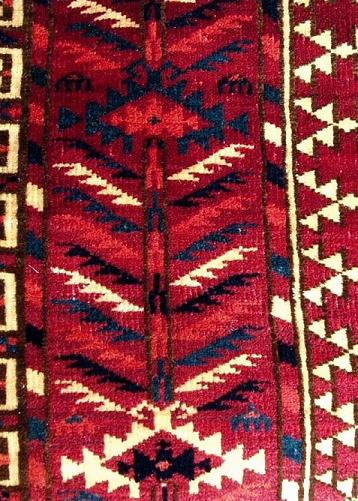
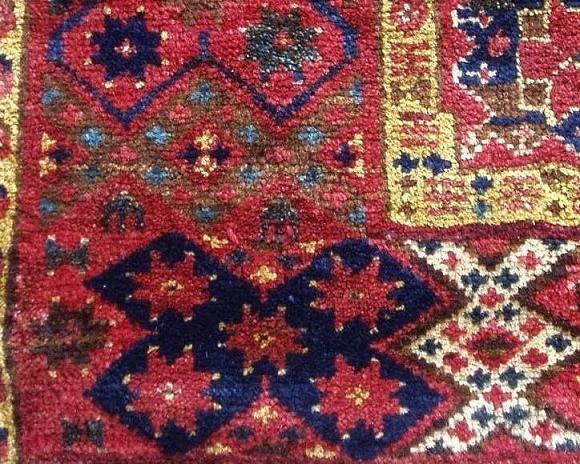
Posted by Martin Andersen on 08-23-2007 04:06 AM:
Hi All
And aren't the (rather fork like) signs on the vertical pole in the
Tekke Engsi often referred to as protective dogs ?
Tekke Engsi
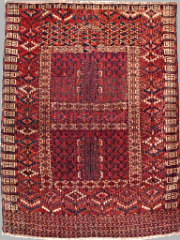
dog ?

I wonder what the source for
this interpretation is ? Any book recommendations ?
regards Martin
Posted by Steve Price on 08-23-2007 05:52 AM:
Hi Martin
I think most figurative readings of motifs on Turkmen rugs
is simply what it looks like to the person who is looking at it. The "guard
dogs" have four projections that sort of look like legs. The same motif has been
called a horse, weaver's comb, probably even an antenna, by others. The nested
tuning forks seen as a minor border on some is called the "soldat" because it
reminded someone of a column of soldiers.
The fact is, nobody knows what
the origin of these motifs is, what they meant in the days when they originated,
and whether that was known (or cared about) by the people that wove rugs in the
19th century.
The notion that they were amulets gets bandied about as
though nothing else makes sense, but, in the words of Sportin' Life (Porgy
and Bess). it ain't necessarily so. Amulets are things that the user
believes afford protection, and it's reasonable to think that some motifs had
amuletic significance; especially, those that look a lot like amulets used by
the descendents of the weavers today. But motifs can also be heraldic
(announcing some state of things - eligibility for marriage, a tribal insignia,
etc.), totemic or, least romantic of all, simply
decoration.
Regards
Steve Price
Posted by Martin Andersen on 08-23-2007 01:44 PM:
Hi Steve
Pure decoration is ok with me. Though I am not sure what
pure decoration would mean in a tribal society. I suppose all patterns and
decorative elements are tied to a specific cultural context, and as such they
are important bearers of identification and identity. The fluctuations of highly
complexed decorative elements in a relatively small and closed cultural
structure as the turkmenian nomadic society is of course extremely interesting.
And I suppose that this has triggered not only my interest in the beauty of the
rugs.
Regarding the symbolic, totemic and semiotic levels in the rugs,
its only very sad that the Russians didn't collect more information before they
altered/destroyed the culture :-( Such ignorance of both imperialism and
communism.
Regarding the Straka collection ,which is truly a most
impressive private collection, I can se in the book that most of the carpets
were donated to the Textile Museum, but the Tekke main carpet (and the "black"
Marasali on the front page) wasn't donated. I wonder if they perhaps were
donated later ? I would love to se the Straka Tekke in first hand if it was in a
public collection. Whereabouts of carpets in our time are probably also quite
complicated :-)
regards Martin
Posted by Steve Price on 08-23-2007 02:37 PM:
Hi Martin
I don't think I've ever been to a place where locals didn't
decorate themselves and their surroundings, usually with brightly colored things
like flowers, painted surfaces, beads, and textiles. I don't see any reason to
believe that the Turkmen don't have a long history of doing this, too. This
isn't to say that none of the motifs on their weavings have other functions as
well, but the universal element of decoration and ornament is almost always
ignored when people talk about them.
Maybe it's not enough of a fantasy
to attribute our own characteristics to them, but I'll bet they were more like
us than many ruggies think.
Regards
Steve Price
Posted by Martin Andersen on 08-24-2007 02:41 AM:
Hi All
Just a final thought on these carpets (if nothing new comes
up).
I suppose its fair to say that the carpets represents some kind of local
development which didn't survive the Russian invasion. My own first impression
(which of course is 100% subjective) was something like "holy crap, this carpet
was made under some kind of stress" - and that stress could perhaps be
war/victory/defeat, that would account for someone's need for an extraordinary
amount of protective signs and patterns. And waving the flags everywhere, now
and then, seems to be a part of war.
A contemporary parallel might be the
war rugs from Afghanistan. Pure speculation of course.
Kind regards
Martin
war rug Afghanistan
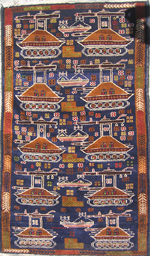
war rug Afghanistan
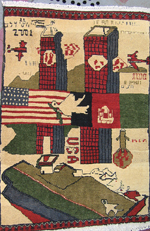
Posted by James Blanchard on 08-24-2007 09:29 AM:
Hi Steve and all,
I am usually the first to agree that it is hazardous
and often wrong to assume that all design elements in a rug have a meaning
beyond their decorative purpose. However, my experience with many Asian cultures
is that they attach meanings to designs more often than we in West do. So I
think it is entirely reasonable to consider that some of the ubiquitous and
somewhat enigmatic designs do serve a function and/or meaning beyond decorative.
I like Jon Thompson's analysis of this; that amulets do not have a
representative purpose (e.g. "this is to represent a protective device"), but an
actual purpose ("e.g."this design is meant to be a protective device").
One of the best and most relevant illustrations is the triangular amulet affixed
to the hat of the young child with her own little loom in Thompson's book
("Carpets from the tents, cottages and workshops..."). I think his analysis is
correct. That is not a decorative piece, but a protective piece. An analogy from
India is the Rangoli, which is a decorative design made by sprinkling rice or
sand powder at the entrance of huts, houses and hotels at different festivals.
These look highly decorative, but many people that I have spoken with,
especially in the villages, explain that the Rangoli is meant to invite (and
sometimes repel) gods and/or goddesses to their home. Not all attach this
significance to the Rangoli, but enough do to make it a relevant
construct.
James.
Posted by R. John Howe on 08-24-2007 09:48 AM:
Mr. Anderson -
You mention that you have recently become interested in
Afghan war rugs and know that this is frowned on in some circles.
Well,
some of the more recent ones likely deserve some frowning, but here's a instance
that might support your interest.
There is a retired, Smith professor
living over my head in the condo above. He is a world-class authority on Roman
architecture. He does not pretend to know anything about rugs or textiles in
particular, but said to me that when Afghan war rugs first began to appear, he
bought one.
He saw it as a noteworthy "historical artifact." Now he's not
a ruggy at all, but I would trust his sense of when appropriately to apply the
designation "historical artifact." He's looked at a lot of historical "material"
over the years.

Regards,
R. John Howe
Posted by Steve Price on 08-24-2007 10:17 AM:
Hi James
I think we're on the same page. Like you, I'm sure there is
(or, at least, was) significance to many of the design elements in tribal and
rustic weavings. But my main point was what I said after affirming that, ...
but the universal element of decoration and ornament is almost always ignored
when people talk about them. Like us, they surely used some forms of
decoration for no reason other than decoration. Like them, we have symbols with
meanings and attach supernatural properties to some of them.
Sorry if I
came off as dismissing the possibility that motifs have significance. With a few
exceptions, though, it's extremely difficult to know whether a particular motif
had symbolic importance, what that importance was, and whether it still had that
symbolic meaning at the time a rug was woven (most of the rugs that we discuss
were done after 1850).
Regards
Steve Price
Posted by Sue Zimmerman on 08-25-2007 02:14 PM:
Interesting thread. Interesting group of rugs. I'm sort of in the 'war rugs
of historic interest' camp with them. Not quite 'tribal'. Not quite
'commercial'. I'd put them in the condo reserved for what I see as their, (in
general), ilk--like 'Polonaise' rugs, Khorrisan rugs with drowning Portuguese,
and other chachkeys for the locals woven into the corners. Things I think of as
being inspired by, and woven for, diplomatic/peace offering/cowtowing, and other
misc. adventures.
Homing in on this group, specifically, looks an awful lot,
to me, that our friends, the Tekke, were at some point playing around with some
big players, as in the Knights of Malta probably via the Russian royalty
faction. Sue
Posted by Steve Price on 08-25-2007 05:13 PM:
Hi All
Just a few words about the so-called Afghan war rugs. They
first appeared soon after the Soviet invasion of Afghanistan (1980 or so, I
think). Their motifs included various weapons and war machines, many of which
appeared to have morphed from traditional design elements. Grenades looked a lot
like botehs, for instance.
They made quite a hit with some elements of
Rugdom, who marveled at the speed with which motifs could morph into more
familiar objects. That very soon led to the realization that there was a
substantial market for them, and they were produced by the thousands in mostly
very poor quality wool, dyes and workmanship to fulfill that market.
The
outcome is that the vast majority of Afghan war rugs are purely commercially
motivated weavings with little significance to the people who wove them except
that they could be sold to westerners who thought they were ethnographic and
historical artifacts.
One final note. The second of the two that Martin
introduced isn't of that genre. It clearly shows the events of September 11,
2001. These events didn't take place in locations with which the weavers were
familiar, and can't possibly be considered to be their record of things
happening in their immediate environment.
Regards
Steve Price
Posted by Unregistered on 08-25-2007 06:20 PM:
quote:
Originally posted by Steve Price
Hi All
One final
note. The second of the two that Martin introduced isn't of that genre. It
clearly shows the events of September 11, 2001. These events didn't take place
in locations with which the weavers were familiar, and can't possibly be
considered to be their record of things happening in their immediate
environment.
Regards
Steve Price
i'm not at all sure why you would choose to make a point
regarding something this obvious, but i would add that many in afghanistan felt
and continue to feel deeply connected to those events, as they were planned from
there, and after the excecution of the attacks, afghanistan was subsequently and
substantially bombed.
cheers,
yitzhak
Posted by Steve Price on 08-25-2007 06:33 PM:
Hi Yitzhak
When you post, please overwrite the word "unregistered" in
the user name field with your name.
The reason I pointed out the fact
that the second of the "Afghan war rugs" that Martin posted isn't an Afghan war
rug (a recognized genre with a fairly specific meaning in Rugdom) is that it was
incorrectly labeled "War rug Afghanistan" in his post. It wasn't a political
statement, just the correction of an error.
And, no offense intended,
but I find it puzzling that you felt the need to point out something as obvious
as the fact that the attacks on the World Trade Center and Pentagon in 2001 were
planned in Afghanistan and precipitated a war on Afghan
soil.
Regards
Steve Price
Posted by Jim Allen on 08-25-2007 08:01 PM:
Martin's Tekke Main
Martin’s Tekke Main
I agree Martin’s Tekke main carpet is attractive
and I like the variety of designs used to separate its main border cartouches.
The shape of the main gulls is also pleasingly plump. The number of radiata
surrounding the octagonal design components of the main border seem to be
related to age. Look at plate 28 in Mackie and Thompson. This is the same design
type as Martin’s Tekke main. It has a bare minimum number of radiata surrounding
its octagonal main border design. These radiata remind me of the tillers or
paddles of a boat. Martin’s main carpet has a relatively large amount of area
devoted to its borders. Plate 28 in M&T has relatively less area comprised
of borders. The minor borders of the M&T rug are probably only four knots
wide.
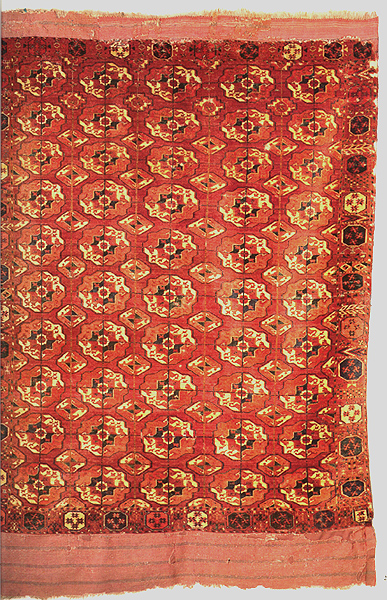
Dating a rug from a picture is fun and we all do it but in the
end one never really knows about a rug until it’s experienced. It often takes
weeks to “experience” a rug; especially a Tekke main carpet. Never the less I
estimate the age of plate #28 In Mackie and Thompson as first half of the 18th
century. I recently got to handle a chuval from this same period and it also had
Salor minor gulls. It was precisely at Khiva prior to about 1750 that the Tekke
coexisted as a valued member of the Salor confederacy. See Richard Woods notes
on the Tekke in VANISHING Jewels. The salor were using lac to dye the fields of
their main carpets a vivid purplish rose during this period. The Tekke learned
to use madder along with special mordants to achieve approximately the same
effect.
It would help if we had some information about the end finishes
of Martin’s rug. Are there any remains of either a kilim or a piled elem?
Another important feature of a traditional Tekke main is its handle. Tekke main
carpets that have been used in the field have a handle more like a fabric than a
carpet. In fact they make miserable carpets for the floor because they are just
too supple. They are impossible to vacuum with an electric vacuum cleaner. I
think it is safe to say that Martin’s Tekke main carpet was woven before 1880.
Please note that the gulls of Martin’s Tekke have the same shape as those of
plate #28 in M&T. I feel quite sure they are the same sub-type.
The
chemche gulls of Martin’s rug have terminal horizontal finishes resembling a
Turkoman bow. This end finish is earlier in general than arrowhead tipped arrow
designs. I think the most likely period for Martin’s rug is the early to mid
19th century probably between 1825 and 1860. The best Tekke color from the mid
19th century is a vivid red the shade of spurting arterial blood. One sees the
very best examples of this madder derived color in mid 19th century Tekke torbas
and occasionally in an ensi. To this end the color of a Tekke main tells one
volumes about the dating of the piece. In the mid 19th century the best Tekke
mains are a glowing red and the redder the better. There is no hint of purple or
brown in the reds of these Merv Oasis period rugs. Earlier rugs from the
environs of Ashkabad and the Akhal Oasis were less red and purpler. Sometimes
they were rather brown in tonality. From the pictures it seems that martin’s rug
is rather purple in hue.
Concerning the interesting octagonal main border
patch John introduced and a similar design in Martin’s rug; this design was
rather widely spread and one even sees it in a larger more elaborate form in
Baluch work. There is a nice Oak chair currently for sale on ebay that’s back
and bottom are covered with pieces of an old Baluch rug. Look at the design
centered on the chair's top section. I think it is the same design group as the
patch's only ramped up in size.
It would be nice to see cataloged all
the design elements used in Tekke main carpets to seperate their main border's
octagonal cartouches. I have a feeling these vivid and archaic designs were in
some way related to a particular group or clans heritage or lineage. Just a
thought!
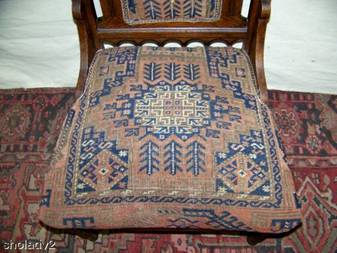
Jim Allen
Posted by Martin Andersen on 08-26-2007 03:23 AM:
Hi Jim
As I am sure you know photographing colors and handle off
carpets is rather difficult. Here's a shot which I think is better color vise
than the previous. The handle of the carpet is very fine (the vacuum cleaner
sure would like to suck the hole carpet up :-) ). The wool is kind of velvet
like.


Regarding the ends,
unfortunately I don't think I can se any trace of the carpets original
end.
Kind Regards Martin
Posted by Martin Andersen on 08-26-2007 10:07 AM:
Hi Jim and All
While I am at it I might as well continue with another
generalized and speculative question about the main gul:
I understand that
there are doubts if the term gul or göl means flower. I wonder if there are any
linguistic news ?
I suppose that it´s possible that all patterns and motifs
could have had a multitude of more less forgotten iconographic layers
reminiscent. I think I have read somewhere that the center of the guls could be
interpreted as a lake ?
I cant help thinking that the gul form is related to
the form of the yurt. The traditional yurt had as I understand it a rather
strict ritualistic symmetrical furnishing structure - like the gul divided into
quarters (I have seen the same structure in old recordings of mongolian yurts)
:
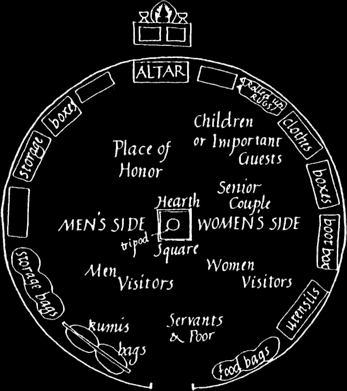
Perhaps the
gul, besides its other functions as decoration and tribes mark, could also be
seen as a kind pictorial centering of home (and world). And the overall layout
of the carpets could be understood as a multicentered thinking which would be
specific for a nomadic culture ?
Classical Persian carpets are often
interpreted as an garden surrounding a well, and as such a metaphor for paradise
and heaven, and they are mostly singular centered. Could one say as rough
generalization that city carpets of the region tends to be singular centered,
and nomadic tradition rugs tends to be multicentered ?
regards Martin
Posted by Steve Price on 08-26-2007 10:49 AM:
Hi Martin
I believe the word "gul" or "gol", with or without umlauts,
means blossom and also means lake in Turkish and maybe also in Farsi. They may
have other meanings as well.
Steve Price
Posted by Sue Zimmerman on 08-26-2007 11:24 AM:
I seem to be missing the gene which makes it fun to date rugs from pictures
and got, instead, the gene that makes me view weavings knot by knot. Now if my
rug viewing gene understands Jim's rug experiencing gene then the hands on my
alarm clock are circa late Tekke. Ok, whatever. If Jim's rug experiencing gene
were to understand my rug viewing gene he would be forced to recognize that the
Baluch chair motif has absolutely nothing to do with the one being discussed in
this group's rugs. Probably in quite less than a few weeks. Sue
Posted by Martin Andersen on 08-26-2007 11:38 AM:
Hi Steve
Thanks for clearing up the lake :-)
The following is from The
Tribal Gol in Turkmen Carpets, by V.G. Moshkova. http://www.tcoletribalrugs.com/article35Moshkova.html
"...There is no satisfactory translation of the word, 'gol'. The interpretation
of the Salor gol as the Salor 'rose for example must be rejected. The carpet
weavers themselves understand the term gol simply as design or pattern."
Gul/gol seems to be a Persian/Farsi term, perhaps adopted by the Turkmen
?
regards Martin
Posted by Jim Allen on 08-26-2007 02:51 PM:
Martin; these questions lead into diverse dreams of hyperbole, but why not?
“The carpet weavers themselves understand the term gol simply as design or
pattern." Moshkova.
Yes! And pattern patterns the mind so loud… silence
full of sounds abound. Classical Turkoman weavings in my opinion were generally
autodidactic or self explanatory.
The classical era Turkoman main carpet
gulls had spiritual meaningfulness plus they were autodidactic. The Tekke main
carpet gull seems to be a classical form optimally realized with a horizontal to
vertical knot ratio of 1:1 to 1:1.4. Plate 26 in Mackie and Thompson is labeled
an 18th century Tekke main and it is knotted at 10 X 14 KPSI. I think it could
possibly be older than 18th century. An even better looking Tekke main carpet
gull is to be found on the fabulous pair of Arabatchi chuvals collected by James
Ballard and now at the MET. These two chuvals are knotted at 10 X 12 KPSI for a
ratio of 1:1.2.
In Islamic culture direct representation of people or
even animals is forbidden because it’s considered a corruption of the soul.
Interestingly the art of Islamic calligraphy finds its highpoint in magnificent
totally free excursions of the hand and mind whose ink traces reassemble
beautiful living forms such as swans or clouds in the sky. I think Turkoman
gulls are just like this. To the non-initiate a classical Turkoman rug looks
like a nice rug with a simple repeat design that resembles an elephant’s foot
print. To the initiate the classical Turkoman main carpet was a historical
document and a support for the clan’s leaders at gatherings.
The
Turkoman peoples were like exotic bower birds in the vast central Asian steppe.
They looked ordinary enough to the casual observer but to those who got to
witness their matrimonial rites these plain looking birds put on a dazzling
display of color, form, and design. One jewel I gleaned reading O’Donovon was
his observation of a Turkoman seder or leader sitting down to work on a large
carpet in progress. We are not accustomed to thinking about Turkoman males
weaving and it is indeed noteworthy that a high ranking male would do so. I
wonder if the main carpet O’Donovan mentioned was being made for the high
ranking male whom he saw working on it?
Those of us who look obsessively
into these things know that in classical Tekke main carpets no two gulls are
exactly the same. This probably reflects the fact that at least two or three
weavers collaborated on such a large project. There is also a pulse evident in
all classical Tekke main carpets evidenced by changes in the main gulls’ size.
In my experience the gulls generally start out on the low end of relative size.
Then as the piece progresses the weavers start to speculate about how big the
gulls must be in order to come out as near perfect as possible at the far end of
the loom. In a very high percentage of cases the gulls get larger towards the
end of the rug.
The Tekke main carpet gull is like a jewel. What one
sees depends on what angel one
approaches the gull from. The tertiary “X”
forms in Martin’s Tekke main act like commands. They ‘command’ one to look at
the main gulls from the sides or 45 degrees in line with the slope of the X’s.
When I look at a gull this way I see a rather Oriental looking face/head wearing
a pointed cap. Remember this is my personal interpretation and not a statement
of fact.
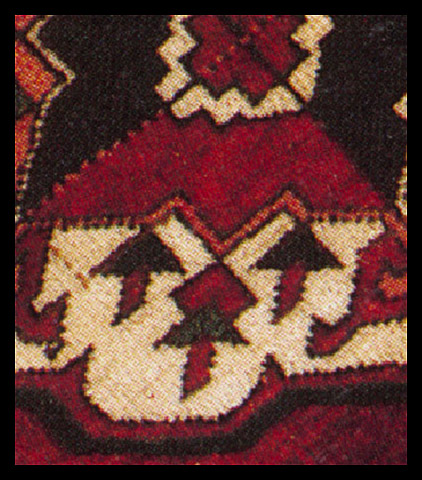
The face is rendered in spiritual near white tones as are the
ears. The colored bird forms guarding the cardinal directions of North, South,
East, and West intrude upon the white of the face shaping ears. The eyes, nose,
mouth, and beard of the white face are composed out of three colored arrows or
lances. I interpret this arrangement of forms as indicating that the face was
informed about movements over the horizon by the ‘calls’ made by the Tekke’s
special or sacred birds.
Incidentally the third law of the US Navy
states; “Take heed what you say of your seniors,
Be your words spoken softly
or plain, Lest a bird of the air tell the matter, -{to the King}-
And so
shall ye hear it again.”.” There are similar phrases in the Old Testament.
Looking at this rather determined and well informed Oriental face; I
shift my attention to its mirror image on the opposite side of the gull.
Instantly the image changes into completely new forms. Now the white reminds me
of the passing of a large bird’s shadow across the ground. Furthermore; where
the birds’ shadow passes there arrows fall. This arrangement of forms and
meanings reminds me of the Blackfoot Indians of our own wild West. The Blackfoot
Indians used lances and some Turkoman commentators have mentioned that the forms
I am calling arrows may have been lances and I certainly agree. The Blackfoot
Indians killed intruders enchroaching upon their sacred lands.
Taking
both mirror image perspectives into consideration the interpretation of the
Tekke main carpet gull design complex seems to go something like this….{We are
the Tekke and here is our image. Our relationship with sacred birds gives US
mastery of the skies above our lands. Where the shadow of our sacred birds
passes: there is the line drawn between yours and ours. We will protect our
grazing lands and waters with our arrows and lances.}
Sue Zimmerman…………
Baluch weavings sometimes exhibit seemingly very old Turkoman iconography or
designs. I have seen 20th century Baluchi weavings sporting what seemed to me to
be very old Turkoman designs or gulls. That is the case with the Baluchi pieces
covering that nice chair on eBay. The gull on that Baluchi fragment looks
medieval to me yet clearly the fragments aren’t so very old. One wonders how
this could be. One idea that crossed my mind was perhaps when a weaving became
so old that it was too tattered to be of any use perhaps the Turkoman discarded
or traded them away. Perhaps the Baluchi took these fragments and incorporated
their designs into their weavings. Again; just a thought.
Jim
Allen
Posted by Steve Price on 08-26-2007 03:36 PM:
Hi Jim
Your personal perceptions reflect you, not the rugs or the
people who made them. You appear to understand this, and you acknowledge it. Not
that you're uninteresting, far from it. But it's very easy for things to lurch
about in directions not relevant to anyone else when personal imaginings become
a focus. I see neat things in clouds sometimes. I don't know of a reason why
anyone else should care.
Let's get back to attributions. You offer a
number of interesting criteria by which you make attributions of age and
geographic origin. Most of these are conventional wisdom, and probably have some
basis in fact. But that basis is largely unknown, and makes you appropriately
reluctant to treat them as absolute.
I'm not sure what "experiencing" a
rug means, unless this is a way of saying that you get good looks at the colors
in various lights, feel the handle as it varies over the dimensions of the rug,
and so forth. Sooner or later, I hope, the process reduces itself to various
forms of sensory input rather than some extrasensory phenomena. Otherwise, it's
just fantasy, and not much of a basis for getting facts. Sue's viewing rugs knot
by knot and having that give her a date attribution sounds like fantasy to me.
Perhaps an explanation of how it works and of the basis on which it can be
trusted would change my mind.
Every rug has two sets of properties. One
is the subjective properties. Is it beautiful? What thoughts and images does it
conjure up in your brain? Stuff like that. There are no facts in them external
to the person experiencing them. Then there are the objective properties. The
colors, dimensions, knot type and density, etc. all exist independently of you
or me. Likewise, the time and place at which it was woven is an objective
reality, although we usually can't pin it down and are left with our
opinions.
Regards
Steve Price
Posted by Ben Mini on 08-26-2007 03:42 PM:
Jim, in your last response your write, "In Islamic culture direct
representation of people or even animals is forbidden because it’s considered a
corruption of the soul."
That's a pretty broad generalization, and it's
basically just not true. Go to Iran today, and you can buy t-shirts with images
of the prophet Mohamed on them. Go to Indonesia (the largest Islamic nation in
the world), and you'll see plenty of direct representations of people-- even
among devout Muslims. Go back further in time-- you'll see animals, people, even
the prophet Mohamed himself (although usually with his face covered) on
miniature paintings from the classical period of Islamic art-- Arab miniatures,
Turkish, Persian, etc.
It's true that, historically speaking, Islamic art
has been more about ornamentation than direct representation, and it's also true
that the Koran and the Bible have a few passages that seem to forbid the
depiction of humas. But it isn't true that Islam in general has consistently
forbid accurate figural representations.
Ben Mini
Posted by Steve Price on 08-26-2007 04:51 PM:
Hi Ben
I think it's interesting that so many of us think of "exotic
cultures" (to most Americans and Europeans, Islam is "exotic") as more or less
monolithic in their practices. There are as many varieties of practice in Islam
as there are of Christianity and Judaism and, for that matter, atheism. As you
note, you don't have to look very hard to find images of people and animals in
Islamic arts, including rugs, notwithstanding the formal
prohibition.
Regards
Steve Price
Posted by Sue Zimmerman on 08-26-2007 07:45 PM:
Steve, I said nothing about age attribution. I didn't even think, or feel
anything about that subject at all not even for a second.
Jim, the chair
seat motif you've brought into this thread still hasn't anything to do with the
Tekke ones you seem adverse to looking at more closely. Call me uninitiated.
Bye, Sue
Posted by Steve Price on 08-26-2007 09:27 PM:
Hi Sue
When you said, ... Now if my rug viewing gene understands
Jim's rug experiencing gene then the hands on my alarm clock are circa late
Tekke I thought you meant "circa late Tekke" to be an age attribution,
especially since you refer to a time measuring device in the same sentence.
"Late Tekke" is vague, but means "relatively recently woven Tekke" to
me.
Since you say that you weren't talking about age attribution, what
the hell were you talking about?
Steve Price
Posted by Sue Zimmerman on 08-26-2007 11:20 PM:
Steve, I am saying that the Baluch chair seat motif Jim saw fit to insert in
this thread has nothing, nothing, to do with those in these Tekke main rug's
borders and that that can be known by looking at it more closely. Just forget
it. I'm asking too much. I give up. Carry on. Sue
Posted by Steve Price on 08-27-2007 05:30 AM:
Hi Sue
The motif on the chair cushion doesn't look very similar to the
one on the patch on Michael's rug to me either, but I fail to see how a "knot by
knot" view relates to that, or what you mean by "late Tekke" if it doesn't
relate to a time. Your frustration at not being understood is obvious enough,
although you don't make the slightest attempt at clarification. I hope my
frustration at dealing with unintellligible posts is, too.
Steve
Price
Posted by James Blanchard on 08-27-2007 08:58 AM:
Hi Sue,
I too find your messages in this thread enigmatic, though I
have done my best to try to understand what you are getting at. My
interpretation is that you think that when we are looking for design linkages
and lineage, we should consider how designs are created "knot by knot". In that
sense, some design groupings have greater structural homology than others (i.e.
not as much difference in how the knotting pattern goes). Is that close to what
you were thinking? If so, I have a follow-up comment or
two.
Cheers,
James
Posted by Sue Zimmerman on 08-27-2007 10:41 AM:
James,
I was trying to point out that this Tekke main rug group's
incorporation of unusual symbols deserves closer inspection and consideration. I
find such an intrusion, especially in the field of Tekke work, highly
significant. It stopped me dead in my tracks. I can't understand why I seem the
only one blown away by it. I am just trying to say stop look at this, but I'm
tired. If I'm the only one who suspects it is possible that the violence Bob
Emry's rug suffered, and it's patch, were anything but accidental that's fine
with me. I'm really, really tired. Sue
Posted by Richard Larkin on 08-27-2007 11:27 AM:
cryptic
Hi Sue:
I too find your posts extremely cryptic. They don't bother me
the way they do Steve. My usual reaction is to wonder what you're getting at,
somewhat along the lines of James. Occasionally, I suspect you do have an
interesting insight, but I can't get at it. It's like that stream of
consciousness stuff in William Faulkner. No doubt, it was very profound, as
several professors in college assured me it was, but I never did get that much
out of it.
In the present instance, before you keel over from fatigue,
would you mention specifically what you think might have happened to Bob Emry's
rug other than an accident?
Posted by Martin Andersen on 08-27-2007 11:30 AM:
Hi All
I certainly think that the patch, and its placement close to
the border pattern which is identical to the tertiary gul is very
interesting.
But according to Jack Cassin there should, in David Reuben's
article in Hali Issue 145, be some samples of carpets where there are no
connection between the two patterns. I suppose there still could be said to be a
high frequency of carpets where the two motifs appear together. Unfortunately I
haven't got issue 145 yet, so I can't look closer into Reuben's
samples.
I have tried an attempt of structural analysis of my carpet
(which is probably flawed) :
Knots asymmetrical open to the right. Kpsi
638.
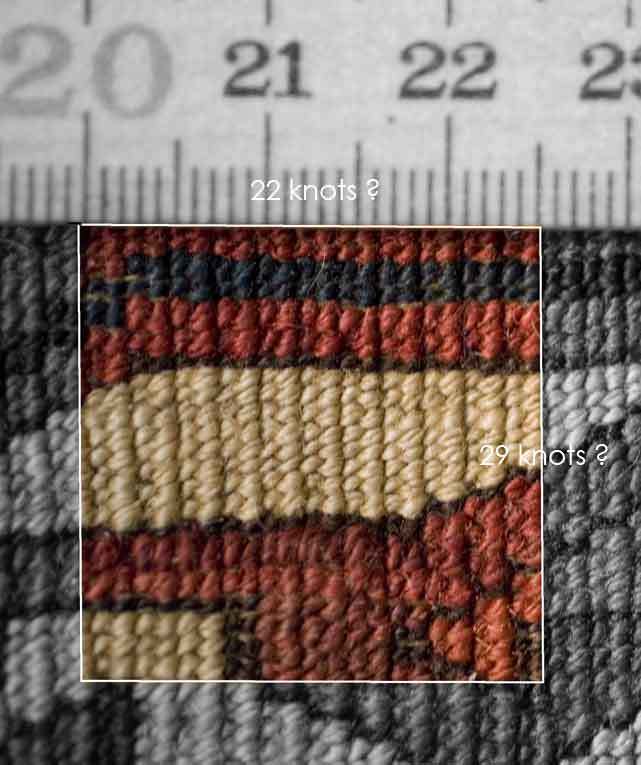
Would
"Woven Structures. A Guide to Oriental Rug and Textile Analysis" by Marla
Mallett, be the right book to learn this stuff from ?
regards Martin
Posted by R. John Howe on 08-27-2007 02:53 PM:
Martin -
In your counting image, you're counting nodes rather than
knots. Ordinarily each knot goes around two warps in a Turkmen weaving. So you
need to count two knot nodes (one for each warp horizontally). I count 11 knots
on the horizontal.
I get 22 knots counting on the vertical.
So if
your have bounded a square inch in your image, that's a kpsi of 242, still
pretty high for a Tekke main carpet. Bags tend to have higher knot counts than
do main carpets.
I just looked at the three Tekke main carpets that
appear in the Mackie-Thompson catalog and they show:
26 10 h X 14 v (140
kpsi)
27 9.5 h X 17 v (162 kpsi)
28 11 h X 18 v (198
kpsi)
Regards,
R. John Howe
Posted by James Blanchard on 08-28-2007 05:44 PM:
permutations, combinations
Hi all,
I thought that this rug is relevant to this discussion,
considering its tertiary gul (which is related to the border element in Martin's
rug) and the use of a border design element that is related to the tertiary gul
in Martin's rug.
I found this rug on the website of an online dealer, so
I expect that the usual prohibition against discussions of its monetary value
should apply.
Cheers,
James
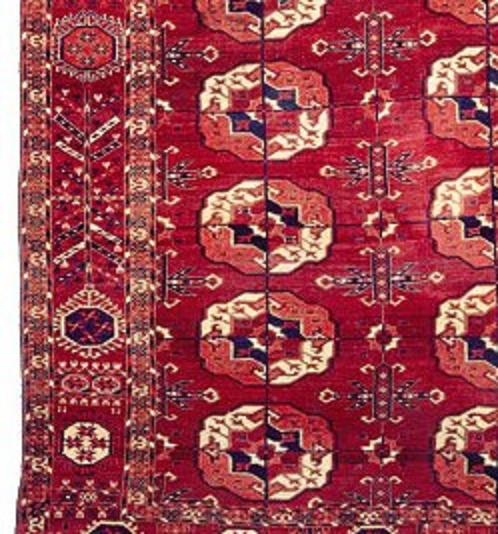
Posted by Steve Price on 08-28-2007 06:10 PM:
Hi Martin
I have HALI number 145, and finally had a chance to look
closely at the carpets in Reubens' article. I only found one with the tertiary
gul (his number 3, photo from a Rippon-Boswell catalog). The photo isn't very
large, so details are hard to see, but it looks like the same tertiary gul. That
carpet doesn't have the odd border motif that appears in yours. Unless I missed
something, none of the other eleven Tekke main carpets illustrated have that
border element either, although there is quite a variety of borders in the
group.
Regarding your question concerning structures, Marla Mallett's
book and website are the best sources of which I'm aware, and I don't know of
anything that I'd call a close second.
Regards
Steve Price
Posted by Martin Andersen on 08-29-2007 03:01 AM:
Hi All
It seems like there there in 4 out of 5 carpets (or 5 out of 6
if we include the patch of Robert Emrys) is a correspondence between the
diagonal crossed motif and the emblematic motif :
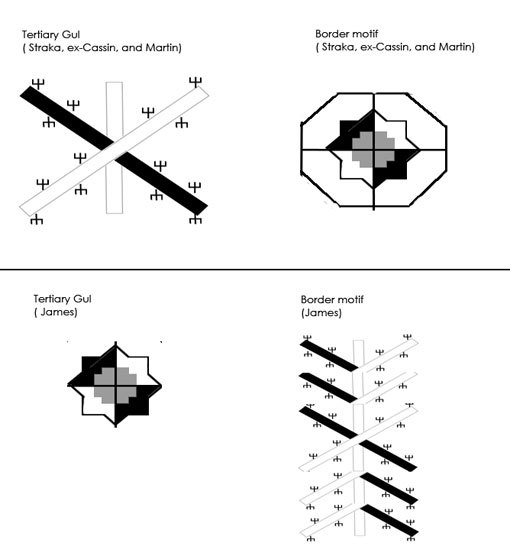
The emblematic motif seems
surely to be contrived from the Tekke Main Gul, and I suppose the crossed motif
could be said to be contrived from general Tekke ornamentation. Still I find it
very interesting that someone somewhere connected these two rather different
motifs. And I think its fair to say that it represent some kind of development
within the living tradition of the Tekke carpets which didn't continue after the
commercialization of the Russian invasion
regards Martin
("4 out of 5
that aint bad" ca Meat Loaf  )
)
Posted by R. John Howe on 08-29-2007 06:56 AM:
Mr. Anderson -
The images in David Reuben's Hali, 145 article are
small and the details of the designs are difficult to read. I used a magnifying
glass and was still not sure of some details.
I think Cassin is
indicating that two rugs in the Reuben article demonstrate that the tertiory
device with the crossed memebers and the border device with the chuval-like gul
do not always occur together. This would suggest that we cannot assume, for
example, that the Emry patch comes from a rug that also has the crossed members
tertiary gul (although it might).
The rugs that Cassin seems to be
pointing to in the Reuben article are 3 and 8. The details show up somewhat
better with scans.
Here is rug 3, first overall and then in a closer
detail.

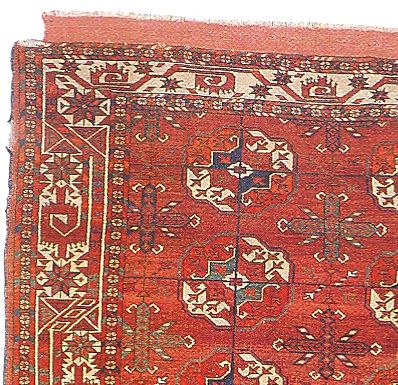
It appears that this piece has a crossed tertiary device, but
not the chuval cartouche in its border.
And below is rug 8. This piece
has the chuval cartouche in its border, but lacks a tertiary gul, unless you
want to count the two very small devices in between the minor guls. It at least
does not have the larger crossed device seen in other pieces.
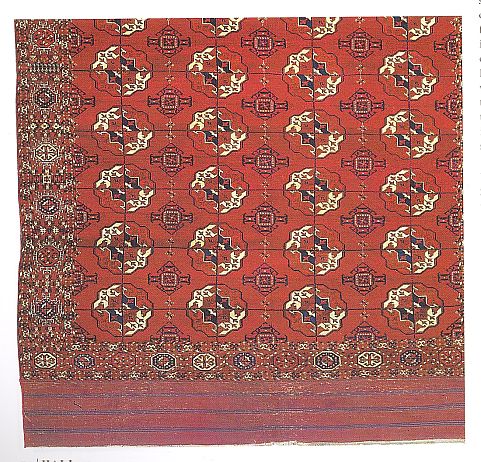
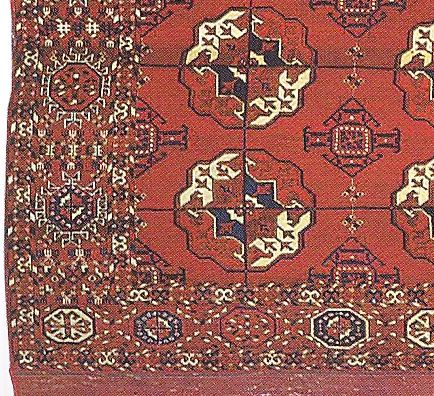
The scans make it possible
to see what is being claimed.
Regards,
R. John Howe
Posted by Martin Andersen on 08-29-2007 09:05 AM:
Hi John
Thanks for the scans.
Its of course difficult to se on the
photos but the crossed tertiary gul on Reubens rug 3 seems rather different -
different endings on the diagonals + no pitchforks. So 4 rugs out of 6 with
direct connection (rather inconclusive).
And you say chuval cartouche ? Have
you seen the cartouche on chuvals ? I would be very interested if you could post
a photo or a reference to these.
regards Martin
Posted by Sue Zimmerman on 08-29-2007 11:00 AM:
Wow, James,
Great job on finding this newest amazing example. Yikes.
Check out what's happened to the minor guls on that rug. Haunting.
Martin,
I very much like what you are doing with your diagrams
but this is Tekke genius you're illustrating and so please forgive me for
seeming nit-picky for pointing a few things out. The diagonals of the tertiary
guls go behind the vertical one and the lattice diagram illustration is not
right. I also think that the variants of the other motif being examined warrant
separate illustrations. I wouldn't bother you with these things if I thought you
couldn't do it. I think you can. Please. Pretty please.
Now if someone
can nudge Bob Emry back awake........Sue
Posted by Steve Price on 08-29-2007 11:11 AM:
Hi Sue
I can't find anything to suggest that someone is awaiting a
followup from Bob Emry. The last mention of his rug that I see is a post from
Rich Larkin, two days ago. It was in response to your riddle about the patch in
Bob's rug being "no accident", in which Rich asked you to explain what you
meant. Since you're up and about, what did you mean? I assume it's more profound
than the obvious fact that the patch was added to the carpet
intentionally.
Steve Price
Posted by R. John Howe on 08-29-2007 12:02 PM:
Mr. Anderson -
I am told that some of my usages can be
puzzling.
I said "chuval cartouche" only as a kind of short hand for
referring to the fact that one of the devices we are discussing seems (to me at
least) a bit like one sort of gul sometimes found on chuvals. And it is in a
cartouche on these main carpet borders.
Others may see this shape as
closer to some major gul usages on main carpets.
But I was not
suggesting something that needs to take us in any new direction.
The gul
in a cartouche in one of the Reuben pieces is not accompanied by the tertiary
device on your piece.
Hope that's clearer.
Regards,
R. John
Howe
Posted by Martin Andersen on 08-29-2007 02:50 PM:
Hi Sue
You are right regarding the drawings. Here is a more correct
schematic drawing of the tertiary gul and the border motif / lattice of James
rug. After looking closer at an enlargement of James photo I don't think that
the center of the the motif is crossed, but rather a horizontal line with
pitchforks (probably a higher number than I have put on it), as shown below. Of
course that loosens the connection ones more, but I still think there is a clear
familiarity.
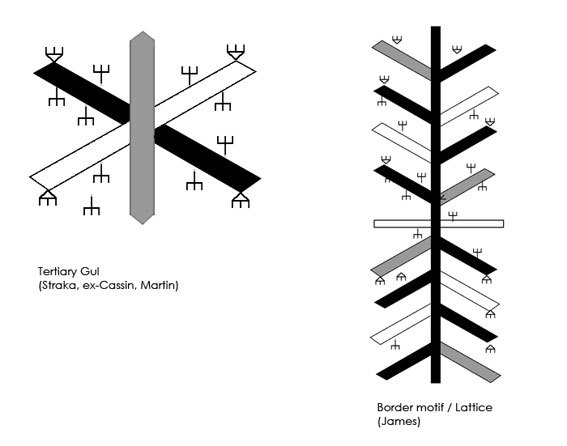
When looking at a magnification of the tertiary guls on James
rug, there seems to be some kind of external markings of the diagonals on all
the guls ? :
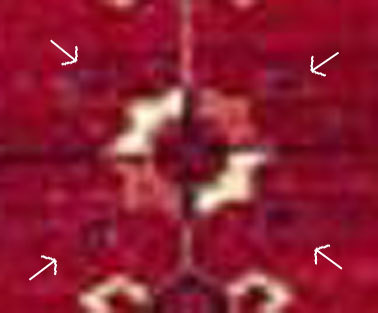
I know that it is generally questionable to categorize only on
design features, but wouldn't it be interesting if it was possible to group a
larger number of carpets according to their border elements (and tertiary guls)
?
And Hi John - its all clear
regards Martin
Posted by Martin Andersen on 08-30-2007 02:24 PM:
Hi All
The Pitchfork design seems to a rather characteristic feature
of my carpet. They are all around the tertiary gul and all around on the side
borders.
While looking closer around the border I noticed this very discrete
singular mirrored pitchfork design in the lower left corner. The mirrored
pitchfork replaces one of the octagonal border elements (shelpe guls?), and it
is certainly not a decorative feature. Would you say it is a signature, a
"tamga", or something else ?:

This is the 9
different border designs with the pitchforks. All elements on the border except
the octagonal cartouches are decorated with the pitchforks.
Does any of
these, I suppose common, border designs have names ? :
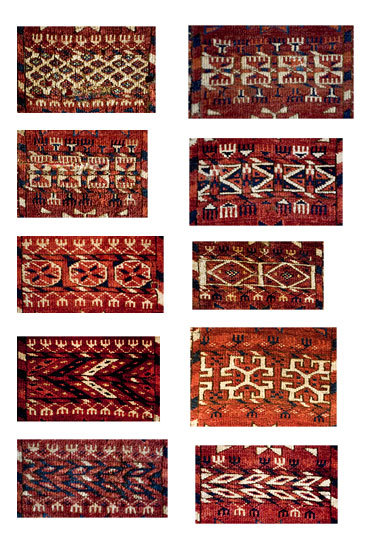
regards
Martin
(sorry for all the many questions)
Posted by Jim Allen on 08-30-2007 03:07 PM:
Martins singualr border design
The object depicted in the lower corner cartouche of your Tekke carpet
reminds me of a Tibetian Buddhist dorje or dorji. “The Vajra (Dorji) is the
symbol of the thunderbolt--the indestructible path of the Vajrayana Buddhism.
The Vajra represents the male principle; it is always held in the right hand;
the Vajra destroys ignorance yet itself is indestructible.” Though it isn't
often discussed Turkoman weavings often contain Buddist iconigraphy and I think
this is a clear example.
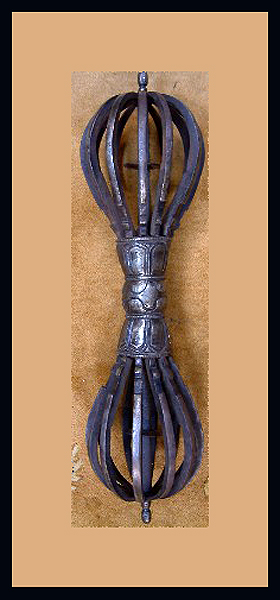
Jim Allen
Posted by Gene Williams on 08-30-2007 09:59 PM:
Menorah
Here is one idea. Actually that 5 tine "picthfork" looks like a 5 branched
version of the 7 branched Jewish Menorah. How could this be in a Turkoman
carpet?
It might be related to the Turkoman/Turkish Khazars who
dominated the Central Asian Steppe from the Byzantine Empire to the Azerbaijan
area, across the mouth of the Volga and the N.Caspian area and on as far as the
Volga bend where the Volga Bulgars resided, with clear dominant influence
running down as far as the mouth of the Amu Darya..Oxus where it spills into the
Aral Sea...and on as far as Bokhara from about 0650 to 1000 AD. They converted
to Judahism in about 0740, probably to keep from being subjected to
politico/religious domination from the Muslims to their south and the orthodox
Christians to their West.
Their downfall came via treachery from
Byzantium, who assumed the Varangian Vikings, who made their appearance in the
area running their dragon boats down the Volga and the Dniepr about 0840, could
take their place in safeguarding the Roman Empire's E. Frontier; the Khazar's
capital and fortresses were sacked by the Vikings in the late 10th century.
Many Khazars subsequently converted to Islam. Huge numbers though,
keeping their Jewish faith, apparently migrated (1) with the Hungarian (Magyar)
hoard which left Khazar control about this time and went to the Alffold around
Budapest (Hungary was documented to be bi-lingual -Turkish/Magyar - until about
1050) or (2) wound up fleeing to E.Europe in separate waves, especially to
Poland and E/NE Europe..(meaning that the majority of the Jewish "race" now
might actually be of Turkish blood.)
Just a thought. ' '
'
Gene
Then again it
could be just an implement for carding wool. I think the menorah bit is more
romantic.
Posted by Jim Allen on 08-30-2007 10:16 PM:
Jewish Turkmen
There is some mention in the literature about Yomud clans on the southeastern
shores of the Caspain Sea who had Jewish customs and lineage. I believe I read
about this in the footnotes to Richard Woods' article in Vanishing Jewels where
he called them the 'black cloaks'. The Jafer Bai comes to mind but I need to
look this up. Wood's small article including his voluminous footnotes is still
the best short history available on the Turkmen in English. I do not think there
is any connection between the Tekke and the Jewish religion except possibly
buying or trading for indigo dyed wool for weaving. This was a virtual Jewish
monopoly through the centuries in Central Asia. Notice that a straight on look
at the dorji reveals 5 terminal arms at both ends and the central collar flares
at its ends. The connection cannot be proved but the visual fit is tight.
Jim
Allen
Posted by James Blanchard on 08-30-2007 10:49 PM:
Hi Martin,
I agree that there are four projections from the central
tertiary "gul" on the carpet I posted. I think it is actually a segment of the
usual centre of a Tekke carpet gul...

James.
Posted by Martin Andersen on 08-31-2007 04:00 AM:
Hi James
Just raveling, and of course some will (with good reason)
find it far fetched but I think the parallel to the Tibetan thunderbolt is very
interesting. The thunderbolt as a symmetric depiction of a violent or dramatic
relation between heaven and earth is a very basic and ancient symbol in the
crossroads between Asia and Europe.
thunderbolt Zeus:
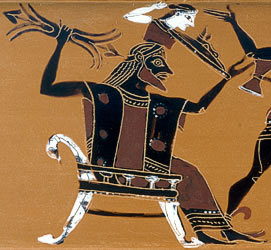
thunderbolt Marduk:
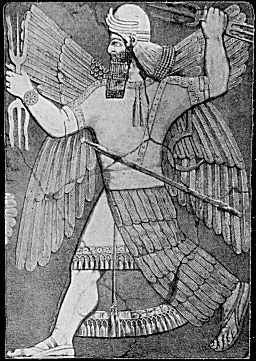
Marduk was a
Mesopotamian thunder god and "Marduk was the patron deity of Babylon and his
symbol is a triangular spade or hoe, the marru, which may reflect his origin as
an agricultural deity" http://www.thebritishmuseum.ac.uk/explore/highlights/highlight_objects/me/c/chalcedony_stamp_seal.aspx
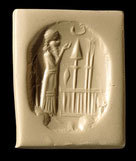
Personally I don't
think one should underestimate how these notions and images have migrated
geographically over time. But In relation to these rugs this is of course pure
speculation.
In pictorial associative thinking (as opposed to logical
rational thinking) there may have been a smooth transition from "comb - hand -
flower- fertility - rain - lightning - thunder - war", all in captured in the
simple protectiv/amuletic picturegram of the pitchfork:

regards Martin
Posted by James Blanchard on 08-31-2007 09:49 AM:
Hi all,
I won't speculate on the various possible origins and meanings
of these "pitchfork" motifs, but the fact that they turn up in many Turkmen
weavings and there is some variety in their shape, the number of tines, etc.
suggests to me that they don't represent a singular meaning. Here are a few
other examples from Moshkova's article "The Tribal Gol in Turkmen Carpets"
(accessed at Thomas Cole's site: http://www.tcoletribalrugs.com/article35Moshkova.html).
James
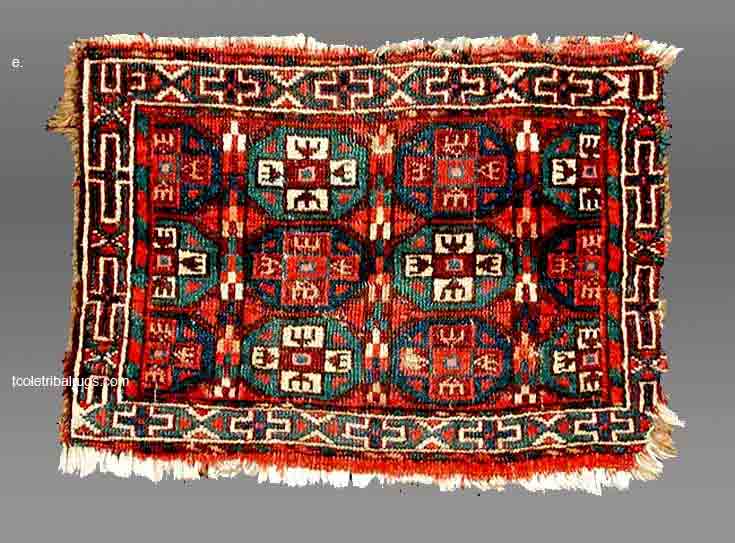
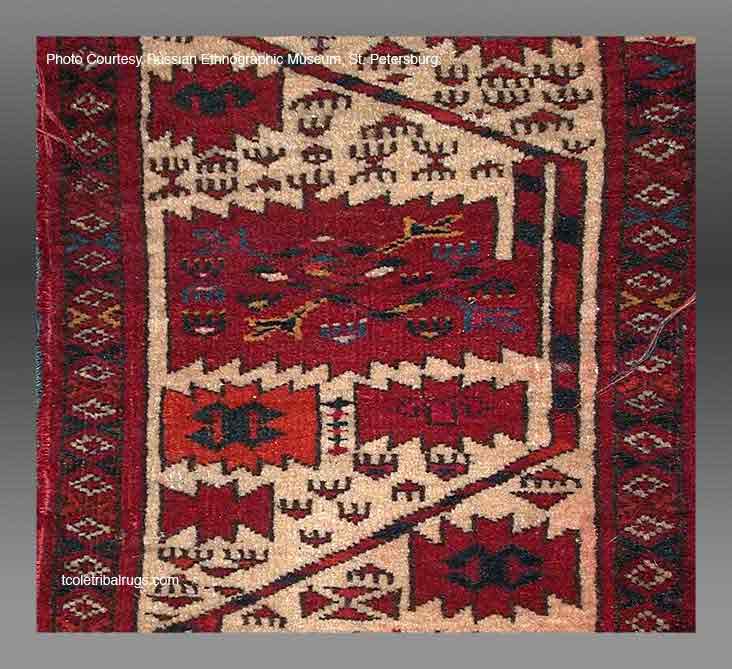
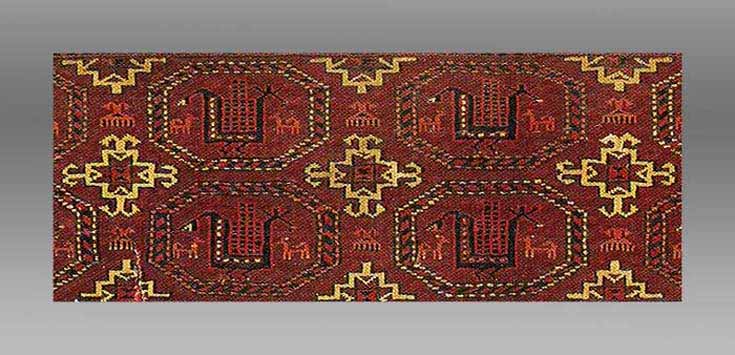
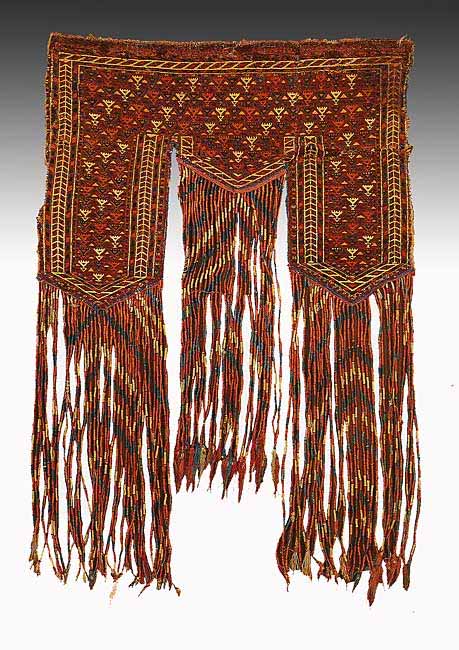
Posted by Martin Andersen on 08-31-2007 01:30 PM:
Hi James and All
You are very right that there are a large amount of
different designs which could be described as pitchforks, or in which the
pitchfork is a part, in the Tekke rugs. I suppose my point is that a very simple
design like this could have been a very open image with fluent transitions of
ascribed "meanings" and iconographies. Some may have seen and used the motif as
purely ornamental others as a protective pictogram (with or without any known
pictorial knowledge's of its origins)
I looked closer at the corners of
the main carpets we are discussing here. And the ex-Cassin rug has two of the
mirrored pitchforks in the left corner (and only in the left corner) in between
2 octagonal cartouches which else vise isn't surrounded by the pitchforks. They
are somehow out of the general layout, but not "signature like" as on my rug.
Strange coincidence ? The Straka rug hasn't as far I can se any features like
this.
ex-Cassin left corner:
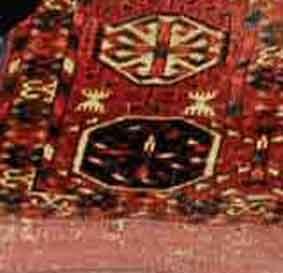
In general it is
difficult to see this kinds of details in reproductions of main carpets. And the
one on my carpet was hard seeing even in real life (red in red). Would you say
that a signature like design like this is often seen in main
carpets?
regards Martin
Posted by Martin Andersen on 09-02-2007 02:24 AM:
Hi All
Just a final pitchfork thought: As far as I can see it seems
like some design elements in the Tekke rugs where continued and developed (or
degenerated) after the Russian commercialization of the rugs : fx the main gul,
the octagonal borders, and the lattice endings. But an element like the
pitchfork seems to have been left behind. This could have been because it was
aesthetically seen as a too crude an ornament - or whatever meaning it may have
had was totally forgotten and looked upon as meaningless old superstition.
Perhaps a mixture of both.
Thanks for the informations and
comments
regards Martin
Posted by James Blanchard on 09-02-2007 10:36 AM:
Hi Martin,
These small design details that look like "amulets" are
often very small and infrequent in a Turkmen rug, so it is not clear to me why a
weaver would insert them into a rug's design if they didn't have some meaning or
purpose for her at the time she tied the knots. I don't think that we should
only expect amulets on very old or completely tribal products. The reality is
that to this day if you travel through rural areas in Afghanistan or Pakistan or
India you will find that families still use various symbols and amulets around
their homes and many hang protective amulets on necklaces for their infants. I
think these cultural practices and beliefs have been more durable than many
other social and cultural traditions.
James.
Posted by Steve Price on 09-02-2007 11:19 AM:
Hi James
Wearing a crucifix or having one or more in the home is
pretty common among American Christians; a mezuzzah on the frame of the
front entrance is not unusual among Jews. These are not purely decorative,
although many of them include decorative elements. You right about amuletic and
talismanic things being common, and it isn't only in what many smugly regard as
the "less developed" parts of the world.
Regards
Steve Price
Posted by Richard Larkin on 09-02-2007 11:22 AM:
Hey gang,
Sorry to be weighing into this thread with observations I
should have made when they were hot. I've just been following this on the fly,
too busy to really digest all the details. I have a little more leisure to
review the whole thing over the Labor Day weekend.
My chief comment is
that I see the Bob Emry patch as essentially older, judging from it's
appearance, than the corresponding border devices on the other carpets, e. g.,
Martin's. I'm surprised no one mentioned it, given the level of detail analysis
we've been doing. Without my going into what features of Bob's make it look
older, does anyone else see it as I do?
My other comment is that while
it's fun to speculate what the weaver's were up to with any given usage, I find
it remarkable that so many devotees are willing to link all sorts of historical,
cultural and chronological development to individual weavings. I recommend a
rereading of all of Steve's cautionary posts in this regard. When this kind of
speculation reaches a certain critical mass, it creates the illusion that much
of it is true.
Posted by Patrick Weiler on 09-02-2007 12:14 PM:
Well, DUH
That is why it is called Truekotek, Richard.
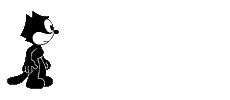
Patrick Weiler
Posted by James Blanchard on 09-02-2007 01:15 PM:
Hi Rich,
I think that the caution that you and Steve have made about
avoiding the tendency to ascribe specific meanings to some of the designs we
find on rugs is a good one. However, my point is that I think we go too far if
we then assume that they probably don't have any meaning to the woman or her
cultural group.
As another example, here is a "Beshir" rug I own that a
main border of "butterfly" designs with internal stars. However, on each side
one of the "butterflies" has the stars replaced by some other "pitchfork" sort
of devices that are similar to what we see on Martin's rug and many other
Turkmen weavings. Perhaps this was just a design flourish by the weaver without
much thought or meaning, but I think a more logical explanation is that these
symbols have some meaning to the weaver that motivated her to include them in
the rug, even if it broke up the overall design.
James.
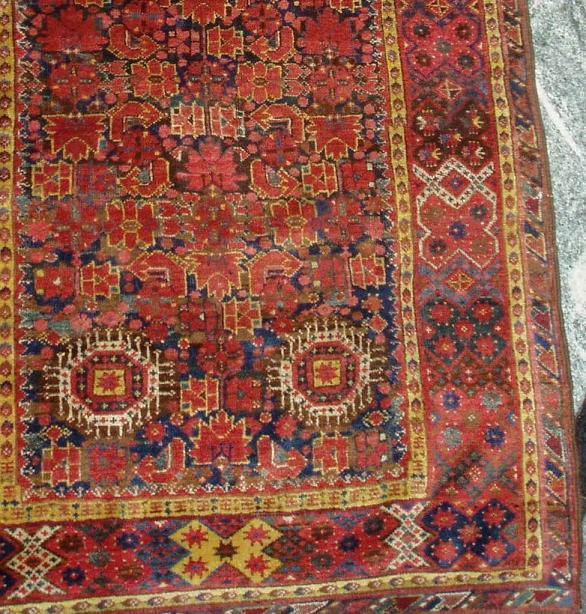
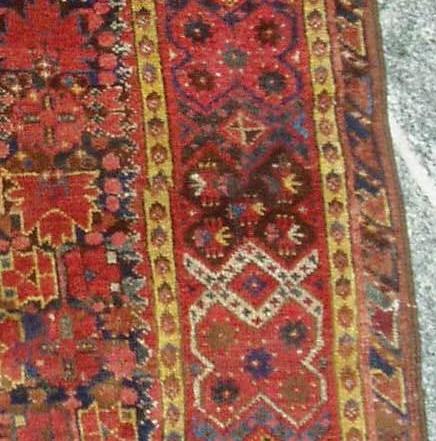
Posted by Martin Andersen on 09-02-2007 01:49 PM:
Hi Richard and All
Well I do think that all the speculation regarding
iconographic and historical parallels have been presented with a lot of
reservations - as exactly speculation. If there seems to be consensus, here and
in the literature, that some elements of the rugs are of iconographic / amuletic
origin I don't suppose its of topic to discuss what that may imply. But I
understand your concern, and some of the speculations have been far
fetched.
Regarding your comments on Emrys patch being older I suppose its
simpler border layout, its rounder form, clearer drawing would make it the older
one ?
If there are considerable time between the cartouches, then I think the
similarities in the details are very interesting. Notice the 4 small triangles
in top and bottom of the octagonal + 4 flowers in each section (on mine + Reuben
8, one cut in half by the centerline). It would be interesting to se closeups of
the Straka and ex-Cassin.
Rober Emrys patch:
.jpg)
Martins rug:
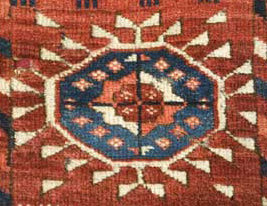
Reubens rug 8 :
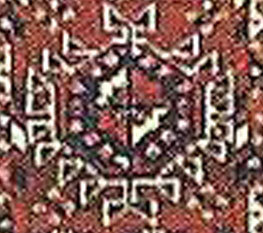
common layout of
the 3:

And James - fantastic butterfly in the Beshir rug
:-)
regards Martin
Posted by Steve Price on 09-02-2007 11:14 PM:
Hi James
I think the probability that most motifs originated as having
significance is very high. Whether that was still true to the weavers in the
latter half of the 19th century is problematic. Maybe a particular motif or
design element had more or less the same significance it had in the more distant
past, maybe it had no special significance beyond the fact that it was simply
part of a design vocabulary by then, maybe it had a significance different than
the one it had originally.
I don't think it makes sense to assume that no
motif had any special significance to the 19th century weaver, but assuming that
every motif did have such significance doesn't get us very far either. The usual
way the question is framed is, "What is the significance (or meaning) of this
motif?" Notice that the assumption that there is a significance is implicit in
that question. The next step, identifying that significance, is an enormous
leap.
Regards
Steve Price
Posted by James Blanchard on 09-02-2007 11:39 PM:
Hi Steve,
I don't disagree with much of what you say. My main point is
that I don't think that the penchant for assigning meaning to amulets and using
them on various objects has necessarily changed as much as many other aspects of
the weaving tradition. I don't see any clear reason why they would have much
less meaning to weavers in the latter half of the 19th century than to those
earlier. If I follow my own experience, there remains a very strong tendency to
employ various symbols for religious and/or cultural purposes. So I don't think
that the timeline is as important for these design elements as one might think,
and I don't think it is overly fanciful to assume that some of these seemingly
extraneous design elements are more than just meaningless repetitions of old
designs in later weavings. I agree that coming to know what (if anything) they
represent is an uncertain endeavour.
James.
Posted by Richard Larkin on 09-02-2007 11:51 PM:
Hi James,
I think it is reasonable to assume that the weavers had all
sorts of notions, superstitious practices, beliefs, or what have you that found
their way into the weavings in one way or another. In addition, there has to be
a ton of whimsy that went into some of the rugs. Our friend, Patrick, the
apostle of horror vacui, will attest to it, at least in the South Persian
weavings. Where I find the going difficult is where the commentator attempts to
attribute specific motives or intentions to the weaver. That, and where the
commentator purports to speak for the specific attitudes and tribal rules about
weaving that were in place among the Turkomans at a given place and time; and
find them to have been applied in a specific weaving that has popped up. With
all due respect to Moshkova, et al, I don't think we have this level of accurate
information.
BTW, not to get personal, but I didn't have you on my card
as a defendant.
Martin,
You have identified the features that make
me think the Bob Emry patch is from an older rug. I wish I could see the rest of
it. There must be analog examples out there somewhere. I hope some adroit
TurkoTekker posts one or two examples.
__________________
Rich
Larkin
Posted by James Blanchard on 09-03-2007 01:08 AM:
Hi Rich,
I think we agree. We often don't know for sure why a certain
design was used and whether it had a particular meaning or significance. To
reiterate, my main point is that I also don't think that we have much evidence
that when used by later weavers these motifs were necessarily stripped of
meaning. To me, that would imply that the significance of such motifs had been
lost in the cultural context, and that doesn't seem to be the case even in
recent times. So I am not defending the notion that we can easily ascribe
meaning, but perhaps you can classify me as defending the notion that some
weavers wove meaningful symbols into their rugs, even in later eras.
Actually, I have a notion that there is a qualitative difference between
the horror vacui of the south Persian weavers and the occasional use of
amulets or other motifs by Turkmen weavers. The former seemed to use various
designs as space fillers, whereas the Turkmen seemed more inclined to use these
sparingly and rarely disrupted the overall correctness of their
designs.
Cheers,
James.
Posted by Richard Larkin on 09-03-2007 10:46 AM:
Hi James,
We do agree. Including about your noted distinction between
the South Persian weaving tradition's approach to filler designs randomly
chosen, in contrast to the Turkoman tradition. In fact, it's the implications of
this distinction, and many more that could be made, that are at the heart of my
minor annoyance with too ready explications of the weavers' attitudes and
practices. Many of the weaving groups that interest us represent traditions that
are very old, in some cases probably more than a hundred generations. Moreover,
in most if not all of them, the weaving is integral to their culture and way of
life. Weavers operating in such a context must have now, and must have had in
the past, complex and deeply ingrained attitudes and approaches to what they
are/were doing, and the importance or significance of how they make the rugs and
what they put into them, in ways we don't grasp.
Having regard to the
Turkoman in particular, as I mentioned in an earlier post, even the early
Russian researchers, who were there and motivated to learn, didn't understand in
important respects what the weavers were about. (BTW, this isn't my own
brilliant observation. I read it the other day while perusing Turkoman
Studies, and I agree with the point.)
I'm not promoting a "know
nothing" attitude. I enjoy trying to figure the rugs out as much as the next
fellow. I just recommend Steve's approach, which is to keep at all times a firm
grip on the principle that we don't really have the answers to many of these
questions.
Posted by Richard Larkin on 09-03-2007 10:56 AM:
BTW, James, I agree with Martin on your Beshir. Those butterfly elements are
terrific. I think we've seen that rug before, but we weren't focusing on those
particular aspects. It's a crackerjack of a border.
Regarding the motif
in the patch from Bob Emry's rug, the more I look at it, the more I'd like to
see the rug it was taken from. It doesn't necessarily appear to be from a
border. Maybe an adept Turkoman reconstructer will show us the larger rug. Maybe
it will be Martin!
Posted by James Blanchard on 09-03-2007 11:07 AM:
Hi Rich,
We are on the same page. It is nearly impossible to now
divine the precise meaning of most of those motifs, though we might find some
clues if we looked at current usage, especially if some motifs have been durable
through the generations. I am always reminded of that triangular cloth piece
with the dangling devices on the hat of a Turkoman child pictured with her first
"loom" in Jon Thompson's book ("Oriental Carpets from the Tents, Cottages, and
Workshops of Asia"). To me, it is cleary a relatively recent use of an amulet
that looks a lot like devices we see in old Turkmen weavings. Though we can't
know whether the meanings and purposes are the same, it suggests that the
practice of using such devices remains.
Yes, you have seen that "Beshir"
before, but thanks for the compliments. It is a favourite or ours, and the scale
and dynamism of the border is a main reason.
James.
Posted by Richard Larkin on 09-03-2007 11:41 AM:
Yes, James, I was a rabid devotee at the time Thompson published that
catalog, and I attended the conference in London (my last hurrah). I was taken
with the picture of the child with the amulet on her hat, and bought the
proposition in full.
Posted by James Blanchard on 09-03-2007 12:24 PM:
Hi Rich,
I am not sure what you mean by saying that you "bought the
proposition in full", but I agree to this extent; I am persuaded that the cloth
piece on her hat is an amulet of some sort. Whether that is exactly what is
being depicted on various Turkmen weavings is more speculative, but it does
support the notion that such amulets were and are important to some weavers in
those cultural groups.
James.
Posted by Richard Larkin on 09-03-2007 04:19 PM:
Hi James,
That's the proposition I bought: That the piece of jewelry
is the same item as the image woven into the rug. Or vice versa?! Either way, it
was irresistible.


























































.jpg)


